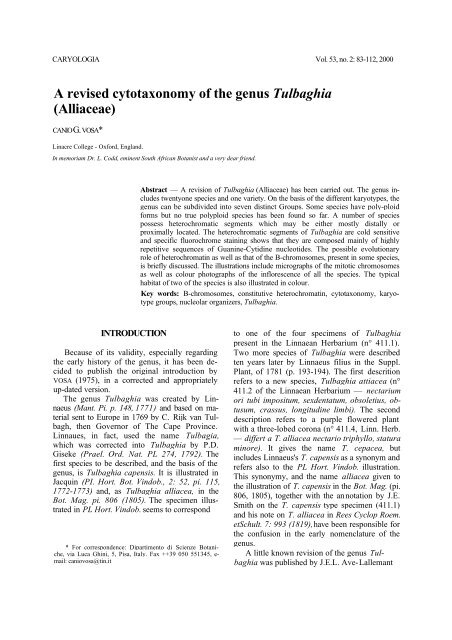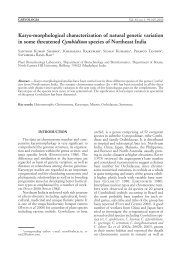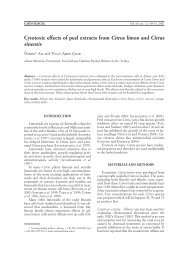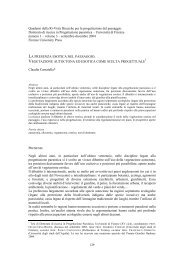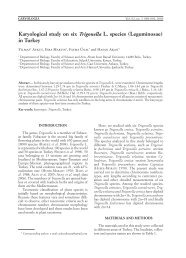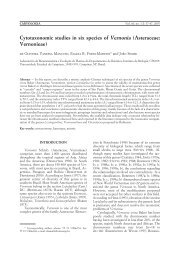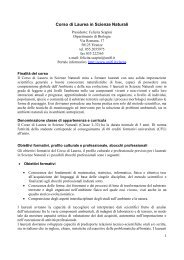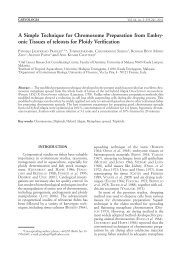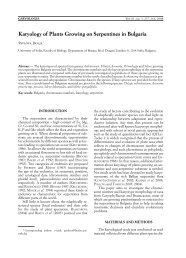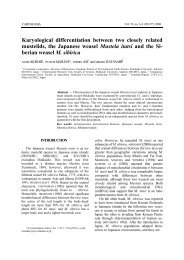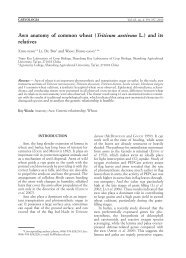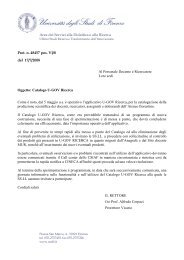A revised cytotaxonomy of the genus Tulbaghia (Alliaceae)
A revised cytotaxonomy of the genus Tulbaghia (Alliaceae)
A revised cytotaxonomy of the genus Tulbaghia (Alliaceae)
You also want an ePaper? Increase the reach of your titles
YUMPU automatically turns print PDFs into web optimized ePapers that Google loves.
CARYOLOGIA Vol. 53, no. 2: 83-112, 2000<br />
A <strong>revised</strong> <strong>cytotaxonomy</strong> <strong>of</strong> <strong>the</strong> <strong>genus</strong> <strong>Tulbaghia</strong><br />
(<strong>Alliaceae</strong>)<br />
CANIO G. VOSA*<br />
Linacre College - Oxford, England.<br />
In memoriam Dr. L. Codd, eminent South African Botanist and a very dear friend.<br />
INTRODUCTION<br />
Because <strong>of</strong> its validity, especially regarding<br />
<strong>the</strong> early history <strong>of</strong> <strong>the</strong> <strong>genus</strong>, it has been decided<br />
to publish <strong>the</strong> original introduction by<br />
VOSA (1975), in a corrected and appropriately<br />
up-dated version.<br />
The <strong>genus</strong> <strong>Tulbaghia</strong> was created by Linnaeus<br />
(Mant. Pi. p. 148, 1771) and based on material<br />
sent to Europe in 1769 by C. Rijk van Tulbagh,<br />
<strong>the</strong>n Governor <strong>of</strong> The Cape Province.<br />
Linnaues, in fact, used <strong>the</strong> name Tulbagia,<br />
which was corrected into <strong>Tulbaghia</strong> by P.D.<br />
Giseke (Prael. Ord. Nat. PL 274, 1792). The<br />
first species to be described, and <strong>the</strong> basis <strong>of</strong> <strong>the</strong><br />
<strong>genus</strong>, is <strong>Tulbaghia</strong> capensis. It is illustrated in<br />
Jacquin (PI. Hort. Bot. Vindob., 2: 52, pi. 115,<br />
1772-1773) and, as <strong>Tulbaghia</strong> alliacea, in <strong>the</strong><br />
Bot. Mag. pi. 806 (1805). The specimen illustrated<br />
in PL Hort. Vindob. seems to correspond<br />
* For correspondence: Dipartimento di Scienze Botaniche,<br />
via Luca Ghini, 5, Pisa, Italy. Fax ++39 050 551345, email:<br />
caniovosa@tin.it<br />
Abstract — A revision <strong>of</strong> <strong>Tulbaghia</strong> (<strong>Alliaceae</strong>) has been carried out. The <strong>genus</strong> includes<br />
twentyone species and one variety. On <strong>the</strong> basis <strong>of</strong> <strong>the</strong> different karyotypes, <strong>the</strong><br />
<strong>genus</strong> can be subdivided into seven distinct Groups. Some species have poly-ploid<br />
forms but no true polyploid species has been found so far. A number <strong>of</strong> species<br />
possess heterochromatic segments which may be ei<strong>the</strong>r mostly distally or<br />
proximally located. The heterochromatic segments <strong>of</strong> <strong>Tulbaghia</strong> are cold sensitive<br />
and specific fluorochrome staining shows that <strong>the</strong>y are composed mainly <strong>of</strong> highly<br />
repetitive sequences <strong>of</strong> Guanine-Cytidine nucleotides. The possible evolutionary<br />
role <strong>of</strong> heterochromatin as well as that <strong>of</strong> <strong>the</strong> B-chromosomes, present in some species,<br />
is briefly discussed. The illustrations include micrographs <strong>of</strong> <strong>the</strong> mitotic chromosomes<br />
as well as colour photographs <strong>of</strong> <strong>the</strong> inflorescence <strong>of</strong> all <strong>the</strong> species. The typical<br />
habitat <strong>of</strong> two <strong>of</strong> <strong>the</strong> species is also illustrated in colour.<br />
Key words: B-chromosomes, constitutive heterochromatin, <strong>cytotaxonomy</strong>, karyotype<br />
groups, nucleolar organizers, <strong>Tulbaghia</strong>.<br />
to one <strong>of</strong> <strong>the</strong> four specimens <strong>of</strong> <strong>Tulbaghia</strong><br />
present in <strong>the</strong> Linnaean Herbarium (n° 411.1).<br />
Two more species <strong>of</strong> <strong>Tulbaghia</strong> were described<br />
ten years later by Linnaeus filius in <strong>the</strong> Suppl.<br />
Plant, <strong>of</strong> 1781 (p. 193-194). The first descrition<br />
refers to a new species, <strong>Tulbaghia</strong> attiacea (n°<br />
411.2 <strong>of</strong> <strong>the</strong> Linnaean Herbarium — nectarium<br />
ori tubi impositum, sexdentatum, obsoletius, obtusum,<br />
crassus, longitudine limbi). The second<br />
description refers to a purple flowered plant<br />
with a three-lobed corona (n° 411.4, Linn. Herb.<br />
— differt a T. alliacea nectario triphyllo, statura<br />
minore). It gives <strong>the</strong> name T. cepacea, but<br />
includes Linnaeus's T. capensis as a synonym and<br />
refers also to <strong>the</strong> PL Hort. Vindob. illustration.<br />
This synonymy, and <strong>the</strong> name alliacea given to<br />
<strong>the</strong> illustration <strong>of</strong> T. capensis in <strong>the</strong> Bot. Mag. (pi.<br />
806, 1805), toge<strong>the</strong>r with <strong>the</strong> annotation by J.E.<br />
Smith on <strong>the</strong> T. capensis type specimen (411.1)<br />
and his note on T. alliacea in Rees Cyclop Roem.<br />
etSchult. 7: 993 (1819), have been responsible for<br />
<strong>the</strong> confusion in <strong>the</strong> early nomenclature <strong>of</strong> <strong>the</strong><br />
<strong>genus</strong>.<br />
A little known revision <strong>of</strong> <strong>the</strong> <strong>genus</strong> <strong>Tulbaghia</strong><br />
was published by J.E.L. Ave-Lallemant
86 VOSA<br />
nently coloured. Intermediate types include T.<br />
coddii and T. natalemis where <strong>the</strong> perianth segments<br />
are pigmented but in contrasting colours<br />
with <strong>the</strong> corona. Some species such as T. galpinii<br />
and T. rhodesica represent special cases. T.<br />
galpinii is a tiny species which resembles a diminutive<br />
T. capensis with a deeply cut, but not<br />
very fleshy corona, very thin flaccid leaves and a<br />
different karyotype which places it in <strong>the</strong> T. natalensis<br />
group (Group 5). T. galpinii'is endemic<br />
<strong>of</strong> a very restricted area <strong>of</strong> <strong>the</strong> Eastern Cape and<br />
all cultivated collections seem to be self-fertile.<br />
<strong>Tulbaghia</strong> rhodesica is a tropical species. It<br />
has a karyotype similar to that <strong>of</strong> T. cameroni,<br />
which comes from <strong>the</strong> same region, but, in contrast<br />
with his latter species, has brightly colored<br />
flowers with broad perianth segments and a very<br />
short, deeply lobed corona <strong>of</strong> <strong>the</strong> same colour. It is<br />
difficult to define <strong>the</strong> affinities <strong>of</strong> T. rhodesica<br />
which probably represents a very ancient type<br />
well adapted to tropical light forest conditions.<br />
<strong>Tulbaghia</strong> simmleri may represent an extreme<br />
evolutionary type. It possesses some peculiar<br />
characters such as its flower morphology<br />
with somowhat fleshy perianth segments and <strong>the</strong><br />
comparatively small chromosomes (VosA<br />
1975). Its breeding behaviour in crosses with<br />
o<strong>the</strong>r species is interesting showing ra<strong>the</strong>r scarce<br />
affinity. In fact, although a number <strong>of</strong> seeds in<br />
produced in most reciprocal crosses and <strong>the</strong>se<br />
germinate well, <strong>the</strong> resulting plantlets seem to<br />
have a defective root system and fail to grow<br />
(VOSA 1996c).<br />
Field observations have shown that population<br />
structure, in different species, presents some<br />
interesting features. In optimal conditions, all <strong>the</strong><br />
species with highly coloured or white flower,<br />
such a T. violacea, T. cominsii, T. natalensis and<br />
T. coddii, occur <strong>of</strong>ten in dense populations<br />
especially along water courses or in vleis or, as in<br />
<strong>the</strong> case <strong>of</strong> T. simmleri, in light but somewhat<br />
humid mountain forest. All <strong>the</strong> species with<br />
inconspicuosly coloured flowers such as T.<br />
acutiloba, T. cernua, T. alliacea, T. capensis, etc.<br />
occur mostly in very small clumps or, more <strong>of</strong>ten,<br />
as single plants at quite a distance from one<br />
ano<strong>the</strong>r. This situation may probably reflect a<br />
kind <strong>of</strong> strict interaction between flower colour<br />
and eventual pollinators.<br />
Taxonomic treatment<br />
1. <strong>Tulbaghia</strong> capensis Linnaeus, Mant. 2:148,223<br />
(1771); Jacq. Hort. Vindob. 2: 52, PL 115 (1772)<br />
1773);WIUd.,Sp.P1.2:33(1779);Enum.Hort.Berol.<br />
349 (1809); Baker, J. Linn. Soc. Bot. (London) 11:370<br />
(1871), Fl. Cap. 6: 406 (1897); Uph<strong>of</strong>, Herbertia, 10:<br />
45 (1943); Vosa, Ann. Bot. 34: 66-68 (1975); Burbidge,<br />
Notes R. hot. Gds. Edinb. 36: 84 (1978).<br />
TYPE —411.1 (Linn!).<br />
SYNONYMS — <strong>Tulbaghia</strong> pulchella Ave-Lall. in Bull.<br />
Cl. Phys. Math. Acad. Petersb. 3: 204 (1844), nom.<br />
illegit.<br />
<strong>Tulbaghia</strong> alliacea auct. non L. £, Sims, Curtis's<br />
Bot. Mag. 21: t. 806(1805).<br />
ICONOGRAPHY — Jacquin in PI. Hort. Bot. Vindob. 2:<br />
52, PL 115 (1772-1773); Curtis's Bot. Mag. 21: t.<br />
806, 1805; (VosA 1975, fig. 3, Plate I, fig. 3); Plate<br />
IA.<br />
CHROMOSOME NUMBERS — 2n=2x=12; 2n=4x=24;<br />
2n=6x=36 (karyotype C, group 1, fig. 22b; fig. 1).<br />
DISTRIBUTION — Endemic to <strong>the</strong> South Western<br />
Cape. Diploids and tetraploids are found only in <strong>the</strong><br />
eastern part <strong>of</strong> <strong>the</strong> range.<br />
EXSICCATA — Diploids: CAPE. - 3421 (Riversdale):<br />
1.5 km E <strong>of</strong> Heidelberg, Vosa, 294/14 (OXF).<br />
Figs. 1-21 — Mitotic metaphases in <strong>Tulbaghia</strong>: in all micrographs,<br />
<strong>the</strong> positions <strong>of</strong> <strong>the</strong> nucleolar organizing regions are<br />
indicated by arrows. Fig. 1 — <strong>Tulbaghia</strong> capensis (2x), karyotype<br />
C.
CYTOTAXONOMY OF THE GENUS TULBAGHIA 87<br />
Tetraploids: CAPE. - 3421 (Riversdale): just W <strong>of</strong><br />
Heidelberg, Vosa, 680 (OXF). - 3320 (Montagu) 11<br />
km W <strong>of</strong> Drew, Vosa 2459 (OXF).<br />
Hexaploids: CAPE. - 3318 (Cape Town): Waylands<br />
Farm, Darling, Vosa 188/2 (OXF); Schwartzvlei<br />
Farm, Darling, Vosa 189/3, 190/4 (OXF). - 3319<br />
(Worcester): Karroo Garden on rocky hillside, Vosa<br />
232/6 (OXF); 8 km S <strong>of</strong> Villiersdorp, Vosa 143/10<br />
(OXF).<br />
O<strong>the</strong>r exsiccata: CAPE. - 3318 (Cape Town):<br />
Mamre Hills, Malmesbury, Compton 17271 (NBG),<br />
Baker 1643 (NBG). - 3420 (Bredasdorp), Lewis<br />
57187 (NBG); Axelson 263, Tinie Versfeld Reserve,<br />
Darling (NBG); Slangkop, Darling, Rycr<strong>of</strong>t 1778<br />
(NBG).<br />
This taxon is <strong>the</strong> type species <strong>of</strong> <strong>the</strong> <strong>genus</strong>. It is<br />
confined to <strong>the</strong> winter rain region <strong>of</strong> South Africa<br />
and is distinguished from all o<strong>the</strong>rs in <strong>the</strong> <strong>genus</strong> by its<br />
deeply lobed and usually very fleshy corona-lobes.<br />
2. <strong>Tulbaghia</strong> alliacea L. f. in Suppl. PL: 183<br />
(1781); Ave-Lallemant, Bull. Cl. Phys. Math. Acad.<br />
Petersb. 3: 201 (1844); Baker J. Linn. Soc. Bot. London,<br />
11: 371 (1871), Flora Capensis, 6: 405 (1897);<br />
Uph<strong>of</strong>, Herbertia, 10: 48 (1943); Marloth, Fl. PI. S.<br />
Africa, 4: pi. 27 (1915); Vosa, Ann. Bot. (Rome), 34:<br />
70-71 (1975); Burbidge, Notes R. bot. Gds. Edinb.<br />
36: 94-85 (1978).<br />
TYPE —411.2 (Linn).<br />
SYNONYMS — <strong>Tulbaghia</strong> narcissi/lorn Salisb. sensu<br />
Podr. Stirp. 219 (1796); <strong>Tulbaghia</strong> inodora Gaertner,<br />
sensu De Fruct. et Sem. PI. 1: 57 (1833); <strong>Tulbaghia</strong><br />
brachystemma Kunth, sensu Enum. Pi. 4: 483 (1833)..<br />
ICONOGRAPHY — (VosA 1975, fig. 4, Plate II, fig. 3);<br />
Plate IB.<br />
CHROMOSOME NUMBERS — 2n=2x=12; 2n=6x=36<br />
(karyotype C, fig. 2).<br />
DISTRIBUTION — This species, one <strong>of</strong> <strong>the</strong> oldest<br />
established in <strong>the</strong> <strong>genus</strong>, is found only in a ra<strong>the</strong>r restricted<br />
area <strong>of</strong> <strong>the</strong> winter rainfall region <strong>of</strong> South Africa.<br />
It is very variable in size. A population with<br />
2n=6x=36 (hexaploid) is found in <strong>the</strong> middle <strong>of</strong> Cape<br />
Town, in Rondebosch Common. <strong>Tulbaghia</strong> alliacea is<br />
very distinct from all o<strong>the</strong>r species <strong>of</strong> <strong>the</strong> <strong>genus</strong> in its<br />
morphology and distribution which partly shares with<br />
T. capensis.<br />
EXSICCATA — Diploids: CAPE. - 3318 (Cape<br />
Town): dry slopes above Camp's Bay, Vosa 61 (OXF);<br />
moist sandy meadow, among large stones, Botanical<br />
Reserve, Stellenbosch, Vosa 242/9 (OXF); - 3418<br />
(Simonstown): Cape Flats, in fine sandy soil, Vow 48<br />
(OXF).<br />
Fig. 2 — <strong>Tulbaghia</strong> alliacea (2x), karyotype C.<br />
Hexaploids: CAPE. - 3318 (Cape Town): Rondebosch<br />
Common (Cape Town) in wet peaty soil on<br />
low lying ground, Vosa 244/11.<br />
O<strong>the</strong>r exsiccata: CAPE. - 3218 (Clanwilliam):<br />
slopes along <strong>the</strong> river Klo<strong>of</strong>, Olifants Rivier Mountains,<br />
Esterhuysen 15303 (BOL); - 3318 (Cape Town):<br />
Rondebosch Common, Leigh ton 1619 (NBG);<br />
Stellenbosch, Boucher 145 (STE); - 3418 (Simonstown):<br />
Slangkop, Pond 1497 (BOL); 3419 (Caledon):<br />
steep bank above rocks, Riviersonderend Mts.<br />
near Greyton, Esterhuysen 20754 (BOL).<br />
3. <strong>Tulbaghia</strong> cernua Ave-Lallemant, Bull. Class<br />
Phys. Math. Acad. St. Petersb. 3: 202-203 (1844),<br />
Ind. Sem. h. Petr. 9: 25 (1844), Linnaea, 18: 222<br />
(1844); Vosa, Ann. Bot. (Rome), 34: 75-77 (1975);<br />
Vosa, J.S. Afr. Bot. 47: 57-61 (1981).<br />
TYPE — Ave-Lallemant 73.6 (LE!).
88 VOSA<br />
SYNONYMS — <strong>Tulbaghia</strong> alliacea var. affinis Baker,<br />
sensu Link Enum. alt. 1: 310 (1821); Tul-baghia<br />
alliacea forma a Drege sensu Kunth Enum. 4: 483<br />
(1843); <strong>Tulbaghia</strong> ludwigiana Harv. forma macrior,<br />
sensu Kunth. Enum. 4: 483 (1843); <strong>Tulbaghia</strong><br />
campanulata N.E. Br. in Kew Bull. 175: 136 (1901);<br />
type: CAPE. - Queenstown Division: mts. near<br />
Queenstown, Galpin 1660 (K, holo!).<br />
ICONOGRAPHY — Batten & Bokelmann in "Wild<br />
Flowers <strong>of</strong> <strong>the</strong> Eastern Cape", p. 10, pi. 6, fig. 7<br />
(1996); Vosa, 1975, fig. 3, Plate I fig. 3; Vosa in J.S.<br />
Afr. Bot. 47: 57-61 (1981); Plate 1C.<br />
CHROMOSOME NUMBERS — 2n=2x=l2; 2n=4x=24<br />
(karyotype A, fig. 3).<br />
DISTRIBUTION — Eastern Cape to Nor<strong>the</strong>rn<br />
Transvaal. The diploids have been found so far only<br />
in <strong>the</strong> sou<strong>the</strong>rn part <strong>of</strong> <strong>the</strong> range.<br />
EXSICCATA — Diploids: NATAL. - 3030 (Port<br />
Shepstone): High Flats, Vosa 413/32 (OXF); CAPE. -<br />
3129 (Port St. John): 3.5 km S <strong>of</strong> Flagstaff, Vosa 14<br />
(OXF); - 3130 (Port Edward): between sand dunes,<br />
Vow 416/33 (OXF).<br />
Tetraploids: TRANSVAAL. - 3229 (Pieters-burg):<br />
Haenetsburg, near Old German Mission, Vosa 58<br />
(OXF). KWAZULU-NATAL. - 2931 (Stan-ger):<br />
Groenberg (Inanda), Vosa 406/31 (OXF); -2929<br />
(Underberg): Estcourt, Van der Merwe 2544 (PRE);<br />
CAPE. - 3326 (Grahamstown): Haye's Railway<br />
Sidings, Vosa 392/28 (OXF); 1.5 km NE <strong>of</strong> East<br />
London, on <strong>the</strong> side <strong>of</strong> <strong>the</strong> road to Gonubie Park,<br />
Vosa 306/16 (OXF).<br />
O<strong>the</strong>r exsiccata: CAPE. - 3227 (Stutterheim):<br />
King Williams Town, Dyer 254 (PRE); - 3425 (Port<br />
ELizabeth): near <strong>the</strong> town, Eayliss 1567 (K).<br />
VERNACULAR NAMES — Sou<strong>the</strong>rn Sotho: Moe-lela.<br />
Xhosa: Ivimba 'Mpunzi'. KwaZulu: Si'kwa.<br />
<strong>Tulbaghia</strong> cernua is a variable species and <strong>the</strong> two<br />
cytological forms overlap especially in <strong>the</strong> size <strong>of</strong> <strong>the</strong><br />
flowers and <strong>of</strong> <strong>the</strong> leaves. Its main characteristic is<br />
<strong>the</strong> urceolate or barrel-shaped fleshy corona, <strong>the</strong> lanceolate-obtuse<br />
perianth segments and <strong>the</strong> large rhizomatous<br />
base <strong>of</strong> <strong>the</strong> bulb. It can be distinguished<br />
easily from T. acutiloba (with which it shares <strong>the</strong><br />
character <strong>of</strong> <strong>the</strong> corona) by <strong>the</strong> very different leaves<br />
(very much narrower and tapering in T. acutiloba],<br />
by <strong>the</strong> larger corm and by <strong>the</strong> general shape <strong>of</strong> <strong>the</strong><br />
flowers which are smaller, narrower and elongated in T.<br />
acutiloba.<br />
T. cernua has been usually confused with T. alliacea<br />
and indeed many herbarium collections bear this<br />
name. However, it is very distinct and T. alliacea is<br />
found only in <strong>the</strong> winter rainfall region <strong>of</strong> <strong>the</strong> Cape<br />
Province. Besides distribution, <strong>the</strong> differences be-<br />
tween T. alliacea and T. cernua include important details<br />
<strong>of</strong> morphology and <strong>of</strong> karyotype. An illustration<br />
agreeing with T. cernua appears under <strong>the</strong> name <strong>of</strong> T.<br />
alliacea in: "Wild Flowers <strong>of</strong> <strong>the</strong> Eastern Cape Province"<br />
by Batten and Bokelmann, p. 10, PI. 67, fig. 7<br />
(1966). No indication is given about <strong>the</strong> location <strong>of</strong><br />
<strong>the</strong> original plant except that <strong>the</strong> species is known to<br />
occur throughout <strong>the</strong> Cape.<br />
Fig. 3 — <strong>Tulbaghia</strong> cernua (2x), karyotype A.<br />
4. <strong>Tulbaghia</strong> ludwigiana Harv. Bot. Mag. 64: t.<br />
3547 (1837); Dietr. Synops. 2: 1090 (1840); non<br />
Kunth Enum. 4: 482 (1843); Ave-Lallemant, Bull. Cl.<br />
Phys. Math. Acad. Petersb. 3: 203 (1844); Uph<strong>of</strong>,<br />
Herbertia, 10: 46 (1943); Schnizlein, Icon. gr. 1: t. 55<br />
(1949); Vosa, Ann. Bot. (Rome), 34: 75-77 (1975);<br />
Burbidge, Notes R. bot. Gds. Edinb. 36: 86-88<br />
(1978).<br />
TYPE — Harvey in Bot. Mag. 64: t. 3547 (1837):<br />
iconotype!<br />
The species has been described and illustrated<br />
from cultivated material collected by Mr. Zeir (Zeyhr?)<br />
from <strong>the</strong> border <strong>of</strong> "Kafferland" and not known to<br />
have been preserved as herbarium specimen. The<br />
beautiful illustration in Bot. Mag. 64 (1837) has been<br />
selected as iconotype.
CYTOTAXONOMY OF THE GENUS TULBAGHIA 89<br />
Fig. 4 — <strong>Tulbaghia</strong> ludwigiana (2x), karyotype A.<br />
ICONOGRAPHY — (Harvey, 1837, Bot. Mag. 64: t. 3547;<br />
Vosa, 1975, fig. 6, Plate IV, fig. 3); Plate ID.<br />
CHROMOSOME NUMBERS — 2n=2x=12 (karyotype A,<br />
fig. 4).<br />
DISTRIBUTION — Eastern Cape Province.<br />
EXSICCATA — CAPE. - 3327 (Peddie): in grassy<br />
fields at edges <strong>of</strong> Euphorbia scrub, south bank near<br />
<strong>the</strong> mouth <strong>of</strong> <strong>the</strong> Great Fish River, Vosa 398/29<br />
(OXF), Vosa 2171 (OXF); - 3326 (Grahamstown):<br />
W <strong>of</strong> Eraser's Camp, Barker 6993 (NBG).<br />
This species is closely allied to T. cernua but it is<br />
easily distinguished by <strong>the</strong> very broad, lorate leaves<br />
which have a more or less distichous arrangement<br />
and lie flat on <strong>the</strong> ground.<br />
5. <strong>Tulbaghia</strong> dtegeana Kunth in Enum. PI. 4: 483<br />
(1843); Ave-Lall., Bull., Cl. Phys. Math. Acad. Petersb.<br />
3: 203 (1844); Baker, J. Linn. Soc. Bot. (London)<br />
11: 371 (1871) and El. Cap. 6: 405 (1897); Uph<strong>of</strong>,<br />
Herbertia, 10: 46 (1943); Vosa in Ann. Bot.<br />
(Rome), 34: 77-79 (1975); Burbidge, Notes R. bot<br />
Gds. Edinb. 36: 88-89 (1978).<br />
TYPE — CAPE. - 3018 (Kamiesberg): near Lilyfontein<br />
and Ezelfontein, Drege 2658 (BM).<br />
ICONOGRAPHY — (Vosa, 1975, fig. 7, Plate V, fig. 3);<br />
Plate IE.<br />
CHROMOSOME NUMBERS — 2n=2x=12 (karyotype A,<br />
group 2, fig. 22b; fig. 5).<br />
DISTRIBUTION — Sou<strong>the</strong>rn and Western Cape<br />
Province.<br />
EXSICCATA — CAPE. - 3118 (Vanrhynsdorp):<br />
bottom <strong>of</strong> Vanrhysdorp Pass, Vosa 62 (OXF); - 3319<br />
(Worcester): Lemoenspoort, Vosa 1971 (OXF); -<br />
3320 (Towsrivier) Hardy 4228 (NBG); - 2917<br />
(Springbook): Spektakel, Barker 1912 (NBG);<br />
Springbook, Barker 6443 (NBG);-3017 (Hondeklipbaai):<br />
Komaggas Mts., Hall 900 (NBG); - 3119 (Calvinia):<br />
Botterklo<strong>of</strong>, Compton 9642 (NBG); - 3219<br />
(Wupperthal): near Wupperthal, Hall s.n. (NBG);<br />
Cap. B. Spei, Drege 1575 (K).<br />
A very distinct species found around Wupperthal<br />
and Worcester northwards to Springbook. It is<br />
easily distinguished from all o<strong>the</strong>r species by <strong>the</strong> very<br />
short and fleshy corona and by <strong>the</strong> perianth segments<br />
all inserted at <strong>the</strong> same level at <strong>the</strong> base <strong>of</strong> <strong>the</strong><br />
corona.<br />
Fig. 5 — <strong>Tulbaghia</strong> dregeana (2x), karyotype A.
90 VOSA<br />
6. <strong>Tulbaghia</strong> tenuior Krause & Dinter, Bot Jahrb.<br />
45: 1411 (1910); Uph<strong>of</strong>, Herbertia, 10: 50 (1943);<br />
Vosa, Ann. Bot. (Rome) 34: 80-82 (1975);<br />
Burbidge, Notes R. bot. Gds: Edinb. 36: 91-92<br />
(1978).<br />
TYPE — NABIBIA. - 2018 (Grootfontein): near<br />
Grootfontein, Dinter 790 (MI).<br />
SYNONYMS — <strong>Tulbaghia</strong> karasbergensis Glover,<br />
Ann. Bol. Herb. 1: 104 (1915), type: H.H.W. Pearson<br />
8192 (BOLD.<br />
ICONOGRAPHY — (Vosa, 1975, fig. 8, Plate VI, fig. 3);<br />
Plate IF.<br />
CHROMOSOME NUMBERS — 2n=2x=12 (karyotype A,<br />
fig. 6).<br />
DISTRIBUTION — North Western Cape Province and<br />
Nabibia.<br />
EXSICCATA — NABIBIA. - 1918 (Grootfontein): in<br />
dry vlei at Amrib, Schoenfelder S454, 955 (PRE);<br />
2120 (Rietfontein): Rietfontein, Vosa 136 (OXF);<br />
2217 (Windhoek): Windhoek, W. Giess 1598 (PRE).<br />
CAPE. - 2919 (P<strong>of</strong>adder): 3.5 km NE <strong>of</strong> P<strong>of</strong>adder,<br />
Acocks 21797 (PRE); 2911 (Prieska): Prieska, Bryant<br />
576 (K).<br />
<strong>Tulbaghia</strong> tenuior Krause & Dinter is a very distinct<br />
species proper <strong>of</strong> <strong>the</strong> dry and rocky areas <strong>of</strong> <strong>the</strong><br />
NW Cape and <strong>of</strong> Nabibia. It is distinguished by its<br />
starry flowers with very long and pointed perianth<br />
segments and by its short, fleshy corona. It is more or<br />
less deciduous and not very long lived in cultivation.<br />
In <strong>the</strong> wild, it flowers between December and<br />
March. Fig. 6 — <strong>Tulbaghia</strong> tenuior (2x), karyotype A.<br />
Fig. 7 — <strong>Tulbaghia</strong> nutans (2x), karyotype A.<br />
7. <strong>Tulbaghia</strong> nutans Vosa, Ann. Bot. (Rome), 34:<br />
82-84 (1975).<br />
TYPE — TRANSVAAL. - 2330 (Tzaneen):<br />
Haenetzburg, C. Thompson Farm, in dry sandy field<br />
recently burnt, flowering 8/10/1969, Vosa 536/55<br />
(OXF); Isotype G.<br />
ICONOGRAPHY — (Vosa, 1975, fig. 9, Plate VII, fig.<br />
3); Plate IIA.<br />
7).<br />
CHROMOSOME NUMBERS — 2n=2x, 4x (karyotype A, fig.<br />
DISTRIBUTION — Eastern Cape Province and<br />
Transvaal.<br />
EXSICCATA — TRANSVAAL. - 2330 (Tzaneen):<br />
Haenetzburg, in grassy field by <strong>the</strong> road to Dindinnie,<br />
Vosa 538/60 (OXF). CAPE. - 3326 (Grahamstown):<br />
in Euphorbia scrub in sandy soil, between<br />
Cradock and Vaalkrause Track, Vosa 1536 (OXF);<br />
Hounslow Farm, on <strong>the</strong> road to Adelaide, Vosa
CYTOTAXONOMY OF THE GENUS TULBAGHIA 91<br />
2188; Fishriversrand at <strong>the</strong> crossroad to Adelaide,<br />
Vow 2197.<br />
The original description <strong>of</strong> this species relates to a<br />
small population found in <strong>the</strong> Nor<strong>the</strong>rn Transvaal.<br />
Fur<strong>the</strong>r collections near <strong>the</strong> type locality, and in <strong>the</strong><br />
Kruger National Park, have established <strong>the</strong> existence<br />
<strong>of</strong> small populations and <strong>of</strong> scattered plants in which a<br />
tetraploid form predominates. The species is found<br />
also in <strong>the</strong> Eastern Cape but here <strong>the</strong> plants seem to<br />
be exclusively diploid. Thus, <strong>the</strong> ploidy situation and<br />
<strong>the</strong> geographical range <strong>of</strong> <strong>Tulbaghia</strong> nutans appear to<br />
be similar to that <strong>of</strong> <strong>the</strong> more widespread <strong>Tulbaghia</strong><br />
cernua Ave-Lall. which, in <strong>the</strong> same way, has diploid<br />
and tetraploid forms and is found from <strong>the</strong> Eastern<br />
Cape to <strong>the</strong> Transvaal.<br />
8. <strong>Tulbaghia</strong> macrocarpa Vosa, Ann. Bot. (Rome),<br />
34: 84-87 (1975).<br />
TYPE — ZIMBABWE. - 1731 (Harare): amongst<br />
rocks, in an underdeveloped part <strong>of</strong> <strong>the</strong> Botanic Garden,<br />
Harare, Vosa 132 (OXF), isotype G.<br />
ICONOGRAPHY — (Vosa, 1975, fig. 10, Plate VII, fig.<br />
3); Plate HE.<br />
CHROMOSOME NUMBERS — 2n=2x=12 (karyotypeAA,<br />
fig. 8).<br />
DISTRIBUTION — Zimbabwe.<br />
EXSICCATA — ZIMBABWE. - 1731 (Harare): in <strong>the</strong><br />
Botanic Garden, Harare, H.M. Biegel2859.<br />
Fig. 8 — <strong>Tulbaghia</strong> macrocarpa (2x), karyotype AA.<br />
Fig. 9 — <strong>Tulbaghia</strong> transvaalensis (2x), karyotype AA.<br />
This species represents one <strong>of</strong> <strong>the</strong> <strong>Tulbaghia</strong><br />
types which are usually labelled "alliacea" in most<br />
herbarium collection. However, it is very distinct<br />
and, besides its nor<strong>the</strong>rn tropical distribution, it<br />
presents several discriminating characters such as <strong>the</strong><br />
very large ovary, which develops in a long capsule<br />
(hence <strong>the</strong> specific epi<strong>the</strong>t), and <strong>the</strong> ra<strong>the</strong>r fleshy,<br />
laterally expanded corona.<br />
9. <strong>Tulbaghia</strong> transvaalensis Vosa in Ann. Bot.<br />
(Rome), 35: 87-90 (1975).<br />
TYPE — TRANSVAAE. - 2330 (Tzaneen): on<br />
dry, stony hillside, Gordon McNeil Farm, Unkumani,<br />
Dindinnie (Ofcolaco), Vosa 486/49 (OXF),<br />
isotype G.
92 VOSA<br />
ICONOGRAPHY — (Vosa, 1975, fig. 11, Plate IX, fig.<br />
3); Plate IIC.<br />
CHROMOSOME NUMBERS — 2n=2x=12 (karyotype AA,<br />
fig. 9). ,-<br />
DISTRIBUTION — North Eastern Transvaal.<br />
EXSICCATA — TRANSVAAL. - 2330 (Tzaneen):<br />
Unkumani, G. Mac Neil Farm, Dindinnie, Vosa 4867<br />
29 (OXF); grassy slopes S <strong>of</strong> Unkumani, Vosa 1644;<br />
about 2 km SW <strong>of</strong> Unkumani, in recently burnt field,<br />
Vosa 1645 (OXF).<br />
<strong>Tulbaghia</strong> transvaalensis is a very distinct species<br />
found so far only in hilly country in <strong>the</strong> N.E. Transvaal.<br />
For a long time it has been confused with T. alliacea<br />
from which it differs very much in its morphology<br />
and distribution. Its karyotype and certain morphological<br />
characters place T. transvaalensis in <strong>the</strong><br />
group <strong>of</strong> T. macrocarpa Vosa.<br />
Fig. 10 — <strong>Tulbaghia</strong> acutiloba (2x), karyotype AB.<br />
10. <strong>Tulbaghia</strong> acutiloba Harv., Thes. Cap. 2:51, t.<br />
180 (1854); Baker, J. Linn. Soc. Bot. (London), 11:<br />
371 (1871); Baker, Fl. Cap. 6: 404 (1897); Phillips,<br />
Ann. S. Afr. Museum 16: 300 (1917); Uph<strong>of</strong> in Herbertia,<br />
10:46 (1943); De Wild., Sel. Hort. Thes. 3:120<br />
(1902); Vosa, Ann. Bot. (Rome), 34: 90-92 (1975);<br />
Burbidge, Notes R. bot. Gds. Edinb. 36: 96 (1978).<br />
SYNTYPES — EASTERN CAPE. - 3126 (Queestown):<br />
Cooper 463 (K); 3325 (Somerset East): Boschberg,<br />
Macowan 1582 (K).<br />
ICONOGRAPHY — (Vosa, 1975, Plate X, fig. 3); Plate<br />
IID.<br />
CHROMOSOME NUMBERS — 2n=2x=l2 (karyotype AB,<br />
fig. 22a, group 4; fig. 10).<br />
DISTRIBUTION — Eastern Cape Province northward<br />
to <strong>the</strong> Transvaal.<br />
EXSICCATA — TRANSVAAL. - 2528 (Pretoria): in<br />
recently burnt vlei, Delmas Road, 6 km S <strong>of</strong> Pretoria,<br />
Vosa 431/36 (OXF). NATAL. - 2930 (Pietermaritzburg):<br />
Chelmsford Park, Vosa 347/21 (OXF);<br />
2931 (Stanger): Groenberg (Inanda), in short grass at<br />
<strong>the</strong> top <strong>of</strong> <strong>the</strong> hill, Vosa 405/30 (OXF). CAPE. -<br />
3126 (Queenstown), by <strong>the</strong> Dam, in short grass<br />
among rocks, Vosa 373/24 (OXF).<br />
A very small, inconspicuous species which flowers<br />
soon after <strong>the</strong> first spring rain, <strong>of</strong>ten in burnt fields.<br />
It is found, usually, as widely scattered single plants.<br />
VERNACULAR NAMES — Sou<strong>the</strong>rn Sotho: Motsuntsunyane.<br />
11. <strong>Tulbaghia</strong> simmleri Beauv., Bull. Herb. Boissier,<br />
8:988(1908).<br />
TYPE — Shilouvane, (Transvaal), legit H.A. Junod,<br />
ex hortus G; specimen and drawings on two<br />
sheets prepared by G. Beauverd (G, holo!).<br />
SYNONYMS — <strong>Tulbaghia</strong> pulchella Barnes, S. Afr.<br />
Card. 20: 185 (1930), non Ave-Lall.; <strong>Tulbaghia</strong> daviesii,<br />
C.H. Grey in Hardy Bulbs, 2: 572 (1938), nom.<br />
nov. for <strong>Tulbaghia</strong> pulchella Barnes; <strong>Tulbaghia</strong> fragrans<br />
Verdoorn in Fl. PL S. Afr. 11: t. 438 (1931);<br />
R.A. Dyer in Herbertia, 6: 8 (1939); Uph<strong>of</strong>, Herbertia,<br />
10 (1943). Type: E. Transvaal, Pilgrim's Rest<br />
(2430 - DB) Dientje Farm, just N. <strong>of</strong> Bourke's Luck<br />
Pot-holes, Celliers, 8894 (PRE, holo!); Vosa, Ann.<br />
Bot. (Rome) 34: 92-94 (1975); Vosa, J.S. Afr. Bot.,<br />
46: 109-114 (1980).<br />
ICONOGRAPHY — Beauverd, 1908 - Bull. Herb.<br />
Boissier, 8: 988, fig. 2; Barnes (l.c.) fig. A (as T.<br />
pulchella); C.H. Grey (l.c.) as T. daviesii; Verdoorn<br />
(l.c.) fig. 438 (as T.fragrans); C. Letty in "Wild Flowers<br />
<strong>of</strong> <strong>the</strong> Transvaal", pl. 10, fig. 3 (1962) as T. fra-
CYTOTAXONOMY OF THE GENUS TULBAGHIA 93<br />
grans; Vosa, 1975 - Ann. Bot. (Rome), 34: 91, pi. XI,<br />
fig. 3, p. 93, fig. 13 (1975), as T.fragrans; Plate HE.<br />
CHROMOSOME NUMBERS — 2n=2x=l2 (karyotype A,<br />
fig. 11).<br />
EXSICCATA — TRANSVAAL. - 2330 (Tzaneen):<br />
Letaba, Codd 9455 (PRE); - 2430 (Pilgrim's Rest):<br />
The Berg, Vosa 466/43 (OXF); Graskop, Vosa 4687<br />
45 (OXF); Ofcolaco, Cyprus Farm in light moist for est,<br />
Vosa 530/53 (OXF); near Ohrigstad, among rocks<br />
by a stream, Vosa 530/53 (OXF); Bourke's Luck<br />
Potholes, Graskop, Vosa 542/56 (OXF).<br />
The misinterpretation <strong>of</strong> <strong>the</strong> drawings by G.<br />
Beauverd (attached to <strong>the</strong> type specimen <strong>of</strong> T.<br />
simmleri (see VOSA 1980), by BURBIDGE (1978), has been<br />
<strong>the</strong> origin <strong>of</strong> <strong>the</strong> assigning <strong>of</strong> this epi<strong>the</strong>t to T.<br />
violacea Harv.<br />
<strong>Tulbaghia</strong> simmleri is a very decorative and fairly<br />
hardy species widely cultivated, usually under <strong>the</strong><br />
name <strong>of</strong> T. fragrans or T. pulchella, in parks and gardens<br />
in tropical and sub-tropical countries and in cool<br />
greenhouses in temperate regions. It is endemic <strong>of</strong> a<br />
ra<strong>the</strong>r small area <strong>of</strong> <strong>the</strong> Transvaal, in <strong>the</strong> nor<strong>the</strong>rn<br />
Drakensberg. It is found as isolated plants on rocky<br />
ledges and in fairly thick colonies in light<br />
Fig. 11 — <strong>Tulbaghia</strong> simmleri (2x), karyotype A.<br />
Fig. 12 — <strong>Tulbaghia</strong> galpinii (2x), karyotype D.<br />
tropical forest, toge<strong>the</strong>r with Clivia miniata Regel<br />
and epiphytic orchids (mostly Polystachia sp.) and<br />
ferns, at moderate altitude.<br />
12. <strong>Tulbaghia</strong> galpinii Schl, J. Bot. 34: 383<br />
(1894); Uph<strong>of</strong>, Herbertia, 10: 47 (1943); Vosa, Ann.<br />
Bot. (Rome), 34; 94-96 (1975); Burbidge, Notes R.<br />
bot. Gds. Edinb. 36: 98-100 (1978).<br />
TYPE — CAPE. - 3126 (Queestown): Andriesberg,<br />
Golpin 2179 (PRE, isotype!).<br />
ICONOGRAPHY — (Vosa, 1975, fig. 14, Plate XII, fig.<br />
3); Plate IIP.<br />
CHROMOSOME NUMBERS — 2n=2x=12 (karyotype D,<br />
fig. 12).<br />
DISTRIBUTION — Eastern Cape.<br />
EXSICCATA — CAPE. - 3225 (Somerset East): near<br />
Cradock, Vosa 60 (OXF); Bergquagga Park, Vosa<br />
66; 34 km S <strong>of</strong> Somerset East, Vosa 67 (OXF); 48 km<br />
N <strong>of</strong> Cradock, barker 7065 (NBG); Bergquagga<br />
Park, on Bankberg, Liebenberg 7127 (PRE); 43 km S<br />
<strong>of</strong> Somerset East, Acocks 16741 (PRE).<br />
A very small species resembling a diminutive T.<br />
acutiloba in habit but with a scarcely fleshy, deeply<br />
lobed corona and known only from a fairly small area<br />
<strong>of</strong> <strong>the</strong> Eastern Cape. It inhabits dry, rocky country in<br />
grassland or in light scrub <strong>of</strong>ten associated with<br />
dwarf euphorbias.<br />
The three collections cultivated in Oxford (from<br />
<strong>the</strong> Cradock Road, about 11 km from Grahamstown,<br />
<strong>the</strong> Bergquagga Park and from near Somerset East)<br />
are all self-fertile but, under cultivation, usually very<br />
short lived.
94 VOSA<br />
13. <strong>Tulbaghia</strong> leucantha Baker, Flora Capensis,<br />
6:404 (1897); Uph<strong>of</strong>, Herbertia, 10: 47 (1943); Vosa,<br />
Ann. Bot. (Rome), 34: 96-99) (1975).<br />
SYNTYPES — NATAL. - Near <strong>the</strong> river Tugela,<br />
Medley Wood 4408 (K!). CAPE. - Zuurberg (Griqualand<br />
East), MacOwen 1208) (K!).<br />
SYNONYMS — <strong>Tulbaghia</strong> dieterlenii Phillips, Ann. S.<br />
Afr. Museum 16: 300 (1917), type: Leribe (Lesotho),<br />
Dieterlen 361 (BM).<br />
<strong>Tulbaghia</strong> friesii Suesseng, Trans. Rhodes Sci<br />
Ass. 43: 76 (1957).<br />
<strong>Tulbaghia</strong> rhodesica Weimark, Bot. Not. 90: 169<br />
(1937) nom. illeg.<br />
ICONOGRAPHY — (Vosa, 1975, fig. 15, Plate XIII, fig.<br />
3); Plate IIIB.<br />
CHROMOSOME NUMBERS — 2n=2x-12; 2n=4x=24<br />
(karyotype D, fig. 13).<br />
DISTRIBUTION — The diploid forms occur from <strong>the</strong><br />
NE Cape, Lesotho to <strong>the</strong> N Transvaal while <strong>the</strong><br />
tetraploids occur from N Transvaal to Swaziland and<br />
Zimbabwe. In <strong>the</strong> Transvaal, from around Warmbad<br />
and Pietersburg and <strong>the</strong> Kruger Park, <strong>the</strong>re seems to<br />
be an overlap between <strong>the</strong> two forms.<br />
EXSICCATA — Diploids: TRANSVAAL. - 2430<br />
(Pilgrim's Rest): Blyde's River Canyon at 'One Mile<br />
Walk', in short turf among large rocks, Vosa 54/1<br />
(OXF); - 2528 (Pretoria): among rocks near Warmbad,<br />
De Wet 3799 (PRE); in acid, peaty vlei near <strong>the</strong><br />
roadside at Delmas, Vosa 430/35 (OXF); Between<br />
Kestell and Bethlehem by <strong>the</strong> Eland's Bridge, Vosa<br />
1704 (OXF); on rocks in shallow soil by <strong>the</strong> road<br />
from Maseru to Ladibrand, Vosa 1711 (OXF).<br />
Tetraploids: ZIMBABWE. - 1731 (Harare):<br />
Groombdrige, H.M. Eiegel 2860 (SRGH); TRANS-<br />
VAAL. - 2431 (Acornhoek): in dry sandy soil in open<br />
woodland, 10 km N <strong>of</strong> Skukuza, Vosa 449/38<br />
(OXF).<br />
O<strong>the</strong>r exsiccata: TRANSVAAL. - 2528 (Pretoria):<br />
Delmas Road, Codd 2182 (PRE); 10 km W <strong>of</strong><br />
Hammanskraal, Leach 10659 (PRE). SWAZILAND. -<br />
2531 (Mbabane): near Bulunga Poort, Manzini,<br />
Compton 31754 (NBG). ORANGE FREE STATE. -<br />
2828 (Bethlehem): Hoogland, Liebenberg 7291<br />
(PRE). CAPE. - 3028 (Matatiele): Mt. Fletcher, Killick<br />
& Marais 2076 (PRE). NATAL. - 3029 (Zuurberg):<br />
MacOwen & Bolus (1208) (K); Medley Wood<br />
1200 (K).<br />
VERNACULAR NAMES — Sou<strong>the</strong>rn Sotho: leta la ph<strong>of</strong>u.<br />
<strong>Tulbaghia</strong> leucantha is found widespread from<br />
<strong>the</strong> N E Cape to N Transvaal, Swaziland and Zimba-<br />
bwe. It is very variable even within <strong>the</strong> same population<br />
in <strong>the</strong> size <strong>of</strong> <strong>the</strong> flowers, in <strong>the</strong> colour <strong>of</strong> <strong>the</strong> corona<br />
and in <strong>the</strong> leaves which can vary from very this<br />
and grass-like to 5-8 mm broad. Overall, <strong>the</strong> proportion<br />
<strong>of</strong> thin-leaved plants, in a given population, seems to<br />
increase with altitude. The tetraploid forms are much<br />
less variable than <strong>the</strong> diploids but on <strong>the</strong> whole <strong>the</strong>y<br />
have slightly larger flowers. In any case, most <strong>of</strong> <strong>the</strong><br />
o<strong>the</strong>r characters in both forms, overlap in such a way<br />
that it is not possible to distinguish <strong>the</strong>m with certainty<br />
in <strong>the</strong> field, or in herbarium specimens.<br />
The morphological variability <strong>of</strong> <strong>Tulbaghia</strong> leucantha<br />
over its considerable range, has resulted in <strong>the</strong> description<br />
<strong>of</strong> new species, mainly based on herbarium<br />
specimens, by various authors. However, all <strong>the</strong> forms <strong>of</strong><br />
<strong>the</strong> species have a very uniform karyotype and are<br />
interfertile. In any case, <strong>the</strong> epi<strong>the</strong>t T. leucantha, used<br />
by Baker in 1896, has priority over T. dieterlenii Philips<br />
(1917) and over T. friesii Suesseng (1957).<br />
The name T. rhodesica Weimark (1937), cited as a<br />
synonym <strong>of</strong> T. leucantha, is illegitimate because it has<br />
been already used for a very different species (T.<br />
rhodesica R.E. Fries, 1916).<br />
Fig. 13 — <strong>Tulbaghia</strong> leucantha (2x), karyotype D. Note <strong>the</strong><br />
small satellite intercalary to one <strong>of</strong> <strong>the</strong> nucleolar organizer<br />
thread (double arrow).
CYTOTAXONOMY OF THE GENUS TULBAGHIA 95<br />
14. <strong>Tulbaghia</strong> natalensis Baker, Card. Chron. 3,<br />
9: 668 (1891); Baker, Fl. Cap. 6: 405 (1897), Natal<br />
Plants, 1: t. 29 (1899); Uph<strong>of</strong>, Herbertia, 10: 49<br />
(1943), Fl. PI. S. Africa, 25: 979 (1945); Vosa, Ann.<br />
Bot. 34: 99-101 (1975); Burbidge, Notes R. bot. Gds.<br />
Edinb. 36: 89 (1978).<br />
TYPE — NATAL. - 2529 (Underberg): in swamps,<br />
near Moorivier, Medley-Wood 4045 (NH!).<br />
ICONOGRAPHY — (Vosa, 1975, fig. 16, Plate XIV,<br />
fig.3);PlateIIIA.<br />
CHROMOSOME NUMBERS — 2n=2x=12 (karyotypeD,<br />
fig. 14).<br />
DISTRIBUTION — KwaZulu-Natal.<br />
EXSICCATA — NATAL. - 2929 (Underberg):<br />
Thabamhlope, Estcourt, in acid-peaty pasture, Vosa<br />
421/34 (OXF); 28 km S <strong>of</strong> Nottingham Road, Codd<br />
10582 (PRE); 8 km N W <strong>of</strong> Nottingham Road, Van<br />
derMerwe 10581 (PRE); Impendhale, W. Marais 934<br />
(PRE); Moorivier, Stainbank 3845 (NH); Giant's<br />
Castle, Edwards 2174 (NU); Thabamhlope, Estcourt,<br />
Van der Merwe 2585 (PRE).<br />
A ra<strong>the</strong>r attractive species with showy white<br />
flowers, found in vleis and in marshy habitats. It is<br />
endemic <strong>of</strong> Natal and it is almost hardy and easy to<br />
cultivate in acid compost.<br />
Fig. 15 — <strong>Tulbaghia</strong> verdoorniae (2x), karyotype D.<br />
Fig. 14 — <strong>Tulbaghia</strong> natalensis (2x), karyotype D.<br />
15. <strong>Tulbaghia</strong> verdoorniae Vosa & Burbidge,<br />
Ann. Bot. (Rome), 34: 101-104 (1975).<br />
TYPE — TRANSKEL. - 3228 (Willowvale): between<br />
Mpozolo and Mendu in wet soil, 27-01-1966,<br />
R. Wood 161, NU 36321 (holo!).<br />
The name <strong>Tulbaghia</strong> carnosa, published by R.B.<br />
BURBIDGE (1978), may be considered a synonym <strong>of</strong> this<br />
species.<br />
ICONOGRAPHY — (Vosa, 1975, fig. 17, Plate XV, fig.<br />
3); Plate IIIC.<br />
CHROMOSOME NUMBERS — 2n=2x=12 (karyotype D,<br />
fig. 15).<br />
DISTRIBUTION — Eastern Cape, Transkei.<br />
EXSICCATA — CAPE. - 3228 (Butterworth): in a<br />
recently burnt vlei, near <strong>the</strong> railway at Mpuluswa, 15<br />
km NE <strong>of</strong> Butterworth (-AA), 07-10-1977, Vosa<br />
1599 (OXF); on a tussocky, rocky hillside, in pockets<br />
<strong>of</strong> wet soil, near <strong>the</strong> side <strong>of</strong> <strong>the</strong> road near Idutywa (-<br />
AB), 07-10-1977, Vosa 1601 (OXF).<br />
This species has been cultivated for many years in<br />
Botanic Gardens <strong>of</strong> Kew, Oxford and Edinburgh and<br />
it appears in <strong>the</strong> respective herbaria as ei<strong>the</strong>r T.<br />
capensis or T. alliacea. Vosa, in his two cytological
96<br />
A<br />
papers (1966a,b), misapplied <strong>the</strong> name T. dregeana.<br />
to this species which has been known under this<br />
epiteth until 1975.<br />
Two fur<strong>the</strong>r collections <strong>of</strong> <strong>Tulbaghia</strong> verdoorniae<br />
have been made in October 1977 by Vosa (1980),<br />
not very far from <strong>the</strong> original 1966 collection <strong>of</strong> R.<br />
Wood (161, NH 36321), which now represents <strong>the</strong><br />
type.<br />
The species as been named in honour <strong>of</strong> <strong>the</strong> renown<br />
South African Botanist, Miss I.C. Verdoorn.<br />
Following <strong>the</strong> current nomenclatural rules in <strong>the</strong><br />
case <strong>of</strong> a female person, it has been found proper to<br />
amend <strong>the</strong> name verdoornia, as in <strong>the</strong> original description,<br />
into verdorniae.<br />
16. <strong>Tulbaghia</strong> coddii Vosa & Burbidge, Ann.<br />
Bot. (Rome), 34: 101-106 (1975).<br />
TYPE — TRANSVAAL. - 2430 (Pilgrim's Rest):<br />
Graskop, 1400 m. L.E. Codd 6746 (PRE).<br />
The name T. poetica, published by R.B. BUR-<br />
BIDGE (1978), may be considered a synonym <strong>of</strong> this<br />
species.<br />
ICONOGRAPHY — (Vosa, 1975, fig. 18, Plate XVI, fig.<br />
3); Plate HID.<br />
CHROMOSOME NUMBERS — 2n=2x=12 (karyotype D,<br />
fig. 16).<br />
DISTRIBUTION — Endemic to <strong>the</strong> Nor<strong>the</strong>rn<br />
Transvaal.<br />
EXSICCATA — TRANSVAAL. - 2430 (Pilgrim's<br />
Rest): in a small bog just above Lisbon's Falls, Vosa<br />
496/52 (OXF); very near God's Window, Vosa 5317<br />
54 (OXF); in short humid turf by <strong>the</strong> road side 4.5<br />
km from Graskop towards God's Window, Vosa<br />
464/41 (OXF); near Lisbon's Falls, Graskop, Brent<br />
134 (E); marshy ground near Pilgrim's Rest, Davidson<br />
68 (E).<br />
A very attractive small species related to <strong>Tulbaghia</strong><br />
natalensis. It has bright green, very thin leaves<br />
and pink to white flowers with a yellow-green corona<br />
and a sweet smell reminiscent <strong>of</strong> that <strong>of</strong> Narcissus<br />
tazetta. It grows in bogs or in wet turf in acid conditions,<br />
sometimes associated with species otDrosera.<br />
17. <strong>Tulbaghia</strong> montana Vosa, Ann. Bot. (Rome)<br />
35:106-109(1975).<br />
TYPE — NATAL. - 2929 (Underberg): S.E. ridge <strong>of</strong><br />
Giant's Castle, Vosa 70 (OXF), isotype G.<br />
ICONOGRAPHY — (Vosa, 1975, fig. 19, Plate XVII, fig.<br />
3); Plate IIIE.<br />
CHROMOSOME NUMBERS — 2n=2x=12 (karyotype<br />
E, group 6, fig. 22b; fig. 17). • -<br />
Fig. 16 — <strong>Tulbaghia</strong> coddii (2x), karyotype D.<br />
Fig. 17 — <strong>Tulbaghia</strong> montana (2x), karyotype E. (x 2000).<br />
VOS
CYTOTAXONOMY OF THE GENUS TULBAGHIA 97<br />
DISTRIBUTION — This small high mountain species is<br />
apparently confined to <strong>the</strong> South Eastern slopes <strong>of</strong><br />
<strong>the</strong> Natal Drakensberg. It is fairly hardy and very<br />
distinct from <strong>the</strong> o<strong>the</strong>r species <strong>of</strong> <strong>the</strong> <strong>genus</strong> especially<br />
on account <strong>of</strong> its dark-green leaves which have<br />
glaucous undersides, a green midrib and inward<br />
rolled edges. However, it may be confused with T.<br />
acutiloba Harv., especially in scarcely annotated and<br />
badly dried herbarium specimens.<br />
EXSICCATA — NATAL. - 2929 (Underberg):<br />
Drakensberg, on <strong>the</strong> south eastern ridge <strong>of</strong> Giant's<br />
Castle, growing in short grass in ra<strong>the</strong>r humid black<br />
soil at <strong>the</strong> foot <strong>of</strong> large rocks, Vosa 70 (OXF), Burtt<br />
5687 (E); without a precise locality but still on <strong>the</strong><br />
south eastern Drakensberg, Buchanan 3899 (E); 3<br />
km N <strong>of</strong> Rama's Gate, Bayliss 7831, 7781 (GRA).<br />
18. <strong>Tulbaghia</strong> cametoni Baker, Jour. Bot. 16: 321<br />
(1878); Uph<strong>of</strong>, Herbertia, 10: 48 (1943); Vosa, Ann.<br />
Bot. (Rome), 34: 11041 (1975).<br />
TYPE — Tanzania, shores <strong>of</strong> Lake Tanganika,<br />
Cameron 2175 (K!).<br />
ICONOGRAPHY — (Vosa, 1975, fig. 20, Plate XVIII,<br />
fig. 3); Plate IIIE.<br />
CHROMOSOME NUMBERS — 2n=2x=12 (karyotypeAF,<br />
fig. 18).<br />
EXSICCATA — ZAMBIA. - 1024 (Mwinilunga<br />
distr.): Richards 16885 (K); 1426 (Mumbwa distr.):<br />
Mumbwa, Maculay 982 (K); - 1428 (Chilanga distr.):<br />
Mt. Makulo, Vosa 59 (OXF); - 1626 (Choma distr.):<br />
near <strong>the</strong> road from Choma to Itulo, Vosa 68 (OXF).<br />
<strong>Tulbaghia</strong> cameroni Bak. is one <strong>of</strong> <strong>the</strong> tropical<br />
species <strong>of</strong> <strong>the</strong> <strong>genus</strong> and is very variable, with some<br />
plants resembling <strong>the</strong> tetraploid forms <strong>of</strong> <strong>Tulbaghia</strong><br />
leucantha. Examination <strong>of</strong> <strong>the</strong> various herbarium<br />
specimens, does not allow a clear view <strong>of</strong> <strong>the</strong> characteristics<br />
<strong>of</strong> this species and more field work is necessary<br />
to understand its geographical distribution.<br />
19. <strong>Tulbaghia</strong> rhodesica R.E. Fries, Wiss. Ergebn.<br />
Schwed. Rhodesia-Kongo Exped. (1911/ 1912) 1:<br />
227-228 (1916), non <strong>Tulbaghia</strong> rhodesica Weimark,<br />
Bot. Not. 169 (1937); Vosa, Ann. Bot. (Rome) 34:<br />
111-113 (1975); Burbidge, Notes R. hot. Gds.<br />
Edinb.36:97(1978).<br />
TYPE — Zambia. - 828 (Kawambwa distr.): Kalungwisi<br />
River, just S <strong>of</strong> Katwe, R.E. Fries 1911 (LD).<br />
ICONOGRAPHY — (Fl. PL S. Africa, 35: t. 1383;<br />
Vosa, 1975, fig. 21, p. 111); Plate IVA.<br />
CHROMOSOME NUMBERS — 2n=2x=12 (karyotypeAF,fig.<br />
19).<br />
Fig. 18 — <strong>Tulbaghia</strong> cameroni (2x), karyotype AF. Note <strong>the</strong> telocentric<br />
B-chromosome (star).<br />
DISTRIBUTION — Zambia, Sou<strong>the</strong>rn Tanzania.<br />
EXSICCATA — ZAMBIA. - 830 (Mporokoso distr.):<br />
in open bushland in dry sandy soil, near Mporokoso,<br />
Vosa 74 (OXF); Mporokoso, Richards 13717 (K);<br />
Chilongwelo, Richards 2196 (K).<br />
<strong>Tulbaghia</strong> rhodesica is a very beautiful species,<br />
found in Zambia and in S. Tanzania. In <strong>the</strong> colour <strong>of</strong><br />
Fig. 19 — <strong>Tulbaghia</strong> rhodesica (2x), karyotype AF.
98 VOSA<br />
its flowers it resembles T. violacea but cytologically it<br />
belongs to <strong>the</strong> T. cameroni group. It is a very desirable<br />
species from <strong>the</strong> horticultural point <strong>of</strong> view but it<br />
is deciduous and has proved to be somewhat difficult<br />
to cultivate, growing very slowly and flowering<br />
erratically.<br />
20. <strong>Tulbaghia</strong> violacea Harvey in Bot. Mag., 64: t.<br />
3555 (1837); Vosa, Ann. Bot. (Rome), 34: 113-117<br />
(1975) as <strong>Tulbaghia</strong> cepacea L.f.; Vosa, Jl. S. Afr.<br />
Bot., 46: 109-114(1980).<br />
TYPE — Described and illustrated from cultivated<br />
material in <strong>the</strong> Ludwigsburg Garden, Cape<br />
Town, by Harvey in Bot. Mag. 64, t. 3555, 1837<br />
(iconotype!).<br />
SYNONYMS — T. cepacea L.f. in Suppl. PL 194<br />
(1781) quoad descr. excl. syn., nom. illeg. type: 411/4<br />
(LINN); Omentaria cepacea Salisb. Gen. PL Fragm.<br />
87 (1866).<br />
ICONOGRAPHY — (Harvey I.e., Batten & Bokel-mann<br />
in "Wild Flowers <strong>of</strong> <strong>the</strong> Eastern Cape", p. 10, pi. 6,<br />
fig. 6,1966; Vosa, 1975, fig. 22, Plate XX: figs. 3, 4,5,22<br />
and 23, incl. var. as T. cepacea L.f.); Plate IVB.<br />
For <strong>the</strong> legitimacy <strong>of</strong> <strong>the</strong> name <strong>Tulbaghia</strong> violacea<br />
Harvey, see VOSA (1980).<br />
CHROMOSOME NUMBERS — 2n=2x=12 (karyo-type A,<br />
fig. 20).<br />
DISTRIBUTION — From <strong>the</strong> Transkei to <strong>the</strong> SW Cape<br />
near Port Elizabeth.<br />
EXSICCATA — CAPE. - 3227 (Stutterheim): Mt.<br />
Coke, near King William's Town, Compton 144/45<br />
(NBG); - 3228 (Butterworth): at <strong>the</strong> mouth <strong>of</strong> <strong>the</strong><br />
river Kei, Compton 17674 (NBG); - 3224 (Steytlerville):<br />
in rocky scrubland by <strong>the</strong> river Gantoos at<br />
Hankey, Vosa 371/23; 3323 (Willowmore): Zuurberge<br />
Poort, Barker 7132 (NBG); - 3326 (Grahamstown):<br />
in bed <strong>of</strong> dry stream among rocks in <strong>the</strong><br />
Bloukrans, Vosa 354/22,376/26 (OXF); - 3327 (Peddie):<br />
amongst stones in <strong>the</strong> bed <strong>of</strong> <strong>the</strong> river Buffalo,<br />
near East London, Vosa 308/17 (OXF); - 3424 (Humansdorp):<br />
Babeljouw River, Compton 24041 (NBG);<br />
near Humansdorp, Britten 6513 (GRA).<br />
VERNACULAR NAMES — KwaZulu: Icinzini.<br />
All <strong>the</strong> populations <strong>of</strong> <strong>Tulbaghia</strong> violacea, object<br />
<strong>of</strong> <strong>the</strong> present study, show a kind <strong>of</strong> uninterrupted<br />
variability and include a number <strong>of</strong> forms which reasonably<br />
might be given <strong>the</strong> rank <strong>of</strong> varieties. However,<br />
field experience and careful observations during<br />
a number <strong>of</strong> flowering seasons, all over <strong>the</strong> range <strong>of</strong><br />
<strong>the</strong> species and also on cultivated plants, have shown<br />
that considerable differences exist even between<br />
plants <strong>of</strong> <strong>the</strong> same population. Such differences<br />
include, besides <strong>the</strong> dimension <strong>of</strong> <strong>the</strong> plants,<br />
Fig. 20 — <strong>Tulbaghia</strong> violacea (2x), karyotype A.<br />
also <strong>the</strong> size <strong>of</strong> <strong>the</strong> flowers and <strong>the</strong> length and shape<br />
<strong>of</strong> <strong>the</strong> lobes <strong>of</strong> <strong>the</strong> corona. In a previous account by<br />
VOSA (1975), one each <strong>of</strong> <strong>the</strong> most common forms<br />
from two fairly large populations, located 200 km<br />
apart, have been described. A perusal <strong>of</strong> <strong>the</strong> descriptions<br />
shows indeed that <strong>the</strong> two forms differ, but only<br />
in some small details. Herbarium specimens, perforce<br />
limited in number, do not represent <strong>the</strong> intrinsic<br />
variability <strong>of</strong> <strong>Tulbaghia</strong> violacea populations and<br />
cannot be taken as <strong>the</strong> basis for <strong>the</strong> creation <strong>of</strong> <strong>the</strong><br />
taxonomic rank <strong>of</strong> varieties. The exception is <strong>the</strong><br />
establishment <strong>of</strong> <strong>the</strong> var. maritima by VOSA (1975).<br />
This variety is quite distinct morphologically from <strong>the</strong><br />
typical species and exists in fairly small but very<br />
homogeneous populations with a ra<strong>the</strong>r restricted<br />
habitat near <strong>the</strong> sea.<br />
20a. <strong>Tulbaghia</strong> violacea Harvey var. maritima<br />
Vosa, Ann. Bot. (Rome) 34: 113-117 (1975).<br />
TYPE — CAPE. - 3325 (Port Elizabeth): Gantoos<br />
River Mouth, Vosa, 290/12 (OXF) isotype G.<br />
ICONOGRAPHY — (Vosa 1975, fig. 23, Plate XX, fig.<br />
5, Plate IV, fig. 20a, as T. cepacea var. maritima); Plate<br />
IVC.<br />
CHROMOSOME NUMBERS — 2n=2x-12 (karyotype A).<br />
EXSICCATA — CAPE. - 3224 (Humansdorp): near<br />
<strong>the</strong> Krom River mouth, Vosa 63 (OXF); - 3323
CYTOTAXONOMY OF THE GENUS TULBAGHIA 99<br />
(Willowmore): Twee River mouth in sandy soil, Vosa<br />
65 (OXF).<br />
This variety <strong>of</strong> T. violacea Harv. has been found,<br />
so far, only near <strong>the</strong> sea-shore hence <strong>the</strong> epi<strong>the</strong>t maritima.<br />
It differs from <strong>the</strong> type species by its broader,<br />
shiny, dark-green leaves without a prominent central<br />
vein. It has somewhat flat flowers with very small<br />
coronal lobes. All <strong>the</strong> collections are very similar to<br />
one ano<strong>the</strong>r and self-fertile.<br />
21. <strong>Tulbaghia</strong> cominsii Vosa, Jl. S. Afr. Bot. 45:<br />
127-132 (1979).<br />
TYPE — CAPE. - 3227 (Stutterheim): in kommit-tee<br />
soil on rocky ground, <strong>of</strong>ten associated with Ner-ine<br />
filifolia Baker, near Tamaha, 17 km from King<br />
William's Town (-BD), 28-9-57, D. Comins 1718<br />
(RU 10586).<br />
ICONOGRAPHY — (Vosa, 1979, fig. 3, 4); Plate IVD.<br />
CHROMOSOME NUMBERS — 2n=2x=12 (karyo-typeAA,<br />
fig. 21).<br />
DISTRIBUTION — Founds so far only around <strong>the</strong> type<br />
locality.<br />
EXSICCATA — Vosa 1568, 28-10-77 (OXF); Vosa<br />
1781, 12-11-77 (OXF), on both sides <strong>of</strong> <strong>the</strong> road<br />
from King William's Town near Tamaha.<br />
This attractive little species is related to T. violacea<br />
Harv. but differs in its very thin, glaucous leaves,<br />
white or very rarely pinkish flowers with a pink or<br />
purplish perianth tube and a different karyotype. The<br />
glaucous colour <strong>of</strong> <strong>the</strong> leaves is very characteristic and<br />
is due to <strong>the</strong> stomatal pores, which appears as tiny,<br />
white streaks under low magnification.<br />
The chromosome complement <strong>of</strong> T. cominsii is<br />
very interesting: with its four nucleolar chromosomes<br />
<strong>of</strong> type A, it resembles that <strong>of</strong> T. transvaalensis<br />
Vosa and T. macrocarpa Vosa, two taxa quite different<br />
from <strong>the</strong> present species whose morphological<br />
affinities lie with T. violacea. This situation, which<br />
parallels that <strong>of</strong> T. rhodesica Fries and T. cameroni<br />
Bak. (see Vosa, 1975, p. 52), may be an indication <strong>of</strong> a<br />
two-track evolution in which <strong>the</strong> karyotype and <strong>the</strong><br />
phenotype seem to evolve indipendently and, in this<br />
case, along established pathways.<br />
The cytology <strong>of</strong> <strong>Tulbaghia</strong><br />
All <strong>the</strong> species <strong>of</strong> <strong>Tulbaghia</strong> so far studied<br />
have a fairly uniform anatomy and embryology.<br />
The chief characters <strong>of</strong> taxonomic value are <strong>the</strong><br />
morphology <strong>of</strong> <strong>the</strong> flowers but vegetative features<br />
and geographical distribution have <strong>the</strong>ir<br />
importance in <strong>the</strong> differentiation <strong>of</strong> <strong>the</strong> species.<br />
Fig. 21 — <strong>Tulbaghia</strong> cominsii (2x), karyotype AA.<br />
One typical characteristic <strong>of</strong> <strong>the</strong> <strong>genus</strong> is <strong>the</strong><br />
uniformity <strong>of</strong> <strong>the</strong> basic chromosome number<br />
which is x=6 for all <strong>the</strong> species. A few taxa have<br />
polyploid forms but not true polyploid species<br />
has been found as yet. Telocentric B-chromosome<br />
<strong>of</strong> various sizes have been found in four<br />
species (Table 2).<br />
The chromosome complement <strong>of</strong> <strong>Tulbaghia</strong><br />
is composed <strong>of</strong> sub-median chromosomes which<br />
are among <strong>the</strong> largest in <strong>the</strong> plant kingdom: <strong>the</strong><br />
length <strong>of</strong> <strong>the</strong> haploid complement vary from 56.5<br />
to 94.3 μm (Table 1, Figs. 22a and b).<br />
The karyotypes differ mainly in <strong>the</strong> type or<br />
combinations <strong>of</strong> types <strong>of</strong> nucleolar chromosomes<br />
and on this basis <strong>the</strong> <strong>genus</strong> may be subdivided<br />
into seven group <strong>of</strong> species (Table 1).<br />
Ano<strong>the</strong>r character <strong>of</strong> <strong>the</strong> chromosome complement<br />
<strong>of</strong> some species <strong>of</strong> <strong>Tulbaghia</strong> is <strong>the</strong> presence<br />
<strong>of</strong> cold sensitive heterochromatic segments<br />
(H-segments). Fluorochrome staining has<br />
stablished that <strong>the</strong> H-segments <strong>of</strong> <strong>Tulbaghia</strong> are<br />
composed <strong>of</strong> DNA containing highly repetitive<br />
sequences <strong>of</strong> Guanine-Cyti-dine (GC)<br />
nucleotides (see Figs. 23 and 24).
100<br />
A<br />
Fig. 22a — Diagrammatic representation <strong>of</strong> <strong>the</strong> six nucleolar<br />
chromosome types (N.O.R.'s) in <strong>Tulbaghia</strong> drawn according to<br />
<strong>the</strong>ir relative size.<br />
Type A: occurs in 13 species and is a medium sized chromosome<br />
with a submedian centromere and with <strong>the</strong> N.O.R. located<br />
in an intercalary position.<br />
Type B: occurs, in combination with type A, only in one species<br />
(T. acutiloba Harv.) and is <strong>the</strong> second longest <strong>of</strong> <strong>the</strong> complement:<br />
<strong>the</strong> N.O.R. is located in <strong>the</strong> short arm in an intercalary<br />
position.<br />
Type C: occurs in two species (T. capensis L. and T. alliacca L.<br />
f.) and is a subterminal chromosome and <strong>the</strong> second longest <strong>of</strong><br />
<strong>the</strong> karyotype. The N.O.R. is located distally on <strong>the</strong> short arm.<br />
Type D: occurs in five species and is usually <strong>the</strong> shortest <strong>of</strong> <strong>the</strong><br />
complement with a subterminal centromere. The N.O.R. is located<br />
terminally on <strong>the</strong> short arm and <strong>of</strong>ten carries an heterochromatic<br />
"satellite" <strong>of</strong> various sizes.<br />
Type E: occurs in one species (T. montana Vosa) and is a medium<br />
sized chromosome with a submedian centromere. The<br />
N.O.R. is located terminally on its long arm. Type F: occurs, in<br />
combination with type A, in two species (T. rhodesica Fries and<br />
T. cameroni Baker) and is <strong>the</strong> longest <strong>of</strong> <strong>the</strong> complement with a<br />
submedian centromere: <strong>the</strong> N.O.R. is located in an intercalary<br />
position very near <strong>the</strong> centromere.<br />
Fig. 22b — Diagrammatic representation <strong>of</strong> <strong>the</strong> haploid karyotypes<br />
<strong>of</strong> <strong>Tulbaghia</strong>. One species for each karyotype is illustrated<br />
and drawn in accordance with its relative size). Group 1:<br />
T. capensis L. (karyotype C); Group 2: T. dregeana Kunth<br />
(karyotype A); Group 3: T. transvaalensis Vosa (karyotype AA);<br />
Group 4: T. acutiloba Harv. (karyotype AB); Group 5: T. coddii<br />
Vosa & Burbidge (karyotype D); Group 6: T. montana Vosa<br />
(karyotype E); Group 7: T. rhodesica Fries (karyotype AF).<br />
VOS
:YTOTAXONOMY OF THE GENUS TULBAGHIA 101<br />
Plate I. (a) T. capensis L. (x2). (b) T. alliacea L. f. (x2). (c) T. cernua Ave-Lall. (x2). (d) T. ludwigiana Harvey (x2). (e) T. dregeana<br />
Kunth (x2). (f) T. tenuior Krause & Dinter (x2).<br />
Description <strong>of</strong> <strong>the</strong> karyotypes (Table 1)<br />
Group A (six species) - The karyotype consists<br />
<strong>of</strong> five submedian chromosomes one <strong>of</strong><br />
which carries <strong>the</strong> nucleolar attachment in a<br />
proximal position on <strong>the</strong> long arm and one almost<br />
subterminal chromosome which is <strong>the</strong> second<br />
largest <strong>of</strong> <strong>the</strong> complement. In a very few<br />
plants in certain populations, both in <strong>the</strong> dip- loid<br />
form <strong>of</strong> T. cernua and in T. ludwigiana, <strong>the</strong> short<br />
arm <strong>of</strong> this latter chromosome varies in length,<br />
sometimes reaching <strong>the</strong> size <strong>of</strong> <strong>the</strong> shorter arm<br />
<strong>of</strong> <strong>the</strong> second largest chromosome <strong>of</strong> <strong>the</strong> Group<br />
D karyotype. However, in all such cases <strong>the</strong><br />
additional chromosome segment is completely<br />
heterochromatic.
102 VOSA<br />
Group AA (three species) - The karyotype is<br />
overall similar to that <strong>of</strong> group A but <strong>the</strong>re are<br />
two nucleolar chromosomes <strong>of</strong> type A.<br />
Group AB (one species) - The karyotype<br />
consists <strong>of</strong> six submedian chromosomes. The<br />
second largest carries <strong>the</strong> nucleolar attachment in<br />
a proximal position on its short arm (nucleolar<br />
chromosome type B). There is ano<strong>the</strong>r nucleolar<br />
chromosome <strong>of</strong> type A.<br />
Group AF (two species) - The karyotype is<br />
overall similar to that <strong>of</strong> group A, but <strong>the</strong> long est<br />
<strong>of</strong> <strong>the</strong> complement carries a nucleolar attachment<br />
in a very proximal position on its long arm<br />
(nucleolar chromosome type F). There is ano<strong>the</strong>r<br />
nucleolar chromosome <strong>of</strong> type A.<br />
Group C (two species) - The karyotype resembles<br />
that <strong>of</strong> <strong>the</strong> species <strong>of</strong> group A, but <strong>the</strong><br />
nucleolar attachment is carried distally on <strong>the</strong><br />
short arm <strong>of</strong> <strong>the</strong> second largest chromosome.<br />
Plate II. (a) T. nutans Vosa (x3). (b) T. macrocarpa Vosa (x2). (c) T. transvaalensis Vosa (x2). (d) T. acutiloba Harvey (x2). (e) T.<br />
simmleri Beauverd (x4). (f) T. galpinii Schlechter (x2).
CYTOTAXONOMY OF THE GENUS TULBAGHIA 103<br />
Plate III. (a) T. natalensis Baker (x3). (b) T. leucantha Baker (x2). (c) T. verdoorniae Vosa & Burbidge (x2). (d) T. coddiiVosa &<br />
Group D (five species) - The karyotype consists<br />
<strong>of</strong> five sub median chromosomes and one<br />
subterminal chromosome, usually <strong>the</strong> shortest<br />
<strong>of</strong> <strong>the</strong> complement, which carries <strong>the</strong> nucleolar<br />
organizer on its short am. The "satellite" distal<br />
to <strong>the</strong> nucleolar attachment is variable in size<br />
and in some cases may have almost <strong>the</strong> size <strong>of</strong><br />
<strong>the</strong> arm <strong>of</strong> nucleolar chromosome type A. However,<br />
in all <strong>the</strong>se cases, <strong>the</strong> extra chromosome<br />
segment is heterochromatic.<br />
Group E (one species) - The karyotype is<br />
similar to that <strong>of</strong> <strong>the</strong> species <strong>of</strong> group A, but <strong>the</strong><br />
nucleolar attachment is carried on <strong>the</strong> long arm<br />
<strong>of</strong> a submedian chromosome.
104 VOSA<br />
Plate IV. (a) T. rhodesica Fries (x2). (b) T. violacea Harvey (x2). (c) T. violacea Harvey var. maritima Vosa (x4). (d) T. cominsiiVosa (x2).<br />
(e) The craggy hill <strong>of</strong> 'Unkomaninear Ofcolaco (Nor<strong>the</strong>rn Drakensberg): from <strong>the</strong> top to <strong>the</strong> SW <strong>the</strong> habitat <strong>of</strong> T. transvaalensis Vosa. (f)<br />
Nabibia, small rocky inselberg about 75 km N <strong>of</strong> <strong>the</strong> Orange River with a population <strong>of</strong> Aloe dichotoma L. f: <strong>the</strong> typical habitat <strong>of</strong> T.<br />
tenuior Krause & Dinter.
CYTOTAXONOMY OF THE GENUS TULBAGHIA 105<br />
The problem <strong>of</strong> <strong>the</strong> number <strong>of</strong><br />
nucleolar organizers in <strong>Tulbaghia</strong><br />
The number <strong>of</strong> nucleolar organizers in <strong>Tulbaghia</strong><br />
vary from two to four and are <strong>of</strong> five<br />
types (fig. 22a). They differ in number and in<br />
combinations according to and characterizing<br />
<strong>the</strong> species (fig. 22b).<br />
Observation <strong>of</strong> silver-stained interphase nuclei<br />
in several species has shown that <strong>the</strong> amount <strong>of</strong><br />
nucleolar material is very much equivalent<br />
whe<strong>the</strong>r <strong>the</strong>re are two organizers or four. Thus,<br />
it seems that <strong>the</strong>re has been an increase in <strong>the</strong><br />
number <strong>of</strong> organizing sites with a proportional<br />
decrease in <strong>the</strong>ir nucleolar material and in its<br />
syn<strong>the</strong>tizing activity. Silver-staining has also<br />
confirmed, in <strong>Tulbaghia</strong>, <strong>the</strong> intrinsic<br />
heteromorphism <strong>of</strong> <strong>the</strong> nucleolar organizers,<br />
and <strong>of</strong> <strong>the</strong>ir expression in <strong>the</strong> interphase nucleoli,<br />
which seems to be <strong>the</strong> rule in most organisms<br />
and based on a kind <strong>of</strong> dominance on <strong>the</strong><br />
line <strong>of</strong> that demonstrated by NAVASHIN (1934) in<br />
hybrids between species <strong>of</strong> Crepis.<br />
The significance <strong>of</strong> <strong>the</strong> doubling <strong>of</strong> <strong>the</strong> nucleolar<br />
organizing sites must be found in <strong>the</strong><br />
fine tuning <strong>of</strong> <strong>the</strong> interaction between <strong>the</strong> genome<br />
vis-a-vis <strong>the</strong> meiotic process and <strong>the</strong>refore<br />
on <strong>the</strong> inheritance and expression <strong>of</strong> certain<br />
adaptive features. The situation in T. violacea<br />
and T. cominsii, which share a very similar phenotype<br />
but with two organizers in <strong>the</strong> former<br />
and four in <strong>the</strong> latter, is ra<strong>the</strong>r interesting and<br />
demonstrates very well how little we known as<br />
yet on <strong>the</strong> very specialized biology and especially<br />
on <strong>the</strong> evolutionary meaning <strong>of</strong> such differences.
106 VOSA<br />
Constitutive heterochromatin in<br />
<strong>Tulbaghia</strong><br />
Constitutive heterochromatin can be defined<br />
as somewhat dispensable, non-transcrib ing,<br />
usually highly repetitive DNA sequences,<br />
preserved by selection and located on <strong>the</strong> chromosomes<br />
as inheritable, inconvertible seg ments.<br />
It differs from facultative heterochromatin which<br />
is thought to be <strong>the</strong> consequence <strong>of</strong> a cytological<br />
situation in which a certain amount <strong>of</strong> normally<br />
coding DNA is temporarily and reversibly<br />
repressed by a special molecular mechanism. An<br />
example <strong>of</strong> facultative heterochromatin are <strong>the</strong><br />
X-chromosomes in female mammals, one <strong>of</strong><br />
which becomes inactive and heterochromatic<br />
and appears, as it were constitutive<br />
heterochromatin, as a chromocentre in <strong>the</strong><br />
interphase nuclei (i.e. <strong>the</strong> Barr-body <strong>of</strong> female<br />
humans).<br />
Constitutive heterochromatic segments (Hsegments)<br />
are present in several species <strong>of</strong> <strong>Tulbaghia</strong><br />
(Table 2 and see VOSA, 1970, 1975). The Hsegments<br />
number, size and position on <strong>the</strong><br />
chromosomes is variable between and, to a certain<br />
extent, also within species. Such segments<br />
are sensitive to cold treatment and present reduced<br />
fluorescence when stained with certain<br />
fluorochromes, in <strong>the</strong> same way as those found<br />
in Paris, Trillium and Cestrum (DARLINGTON<br />
and LA COUR 1938; DYER 1963; VOSA 1966, 1970,<br />
1973; FILION and VOSA 1980). Experiments have<br />
shown that, in <strong>Tulbaghia</strong>, <strong>the</strong>y consist mainly <strong>of</strong><br />
highly repetitive sequences <strong>of</strong> DNA composed,<br />
for <strong>the</strong> most part, <strong>of</strong> Guanine-Cytidine nucleotides<br />
(PACHMAN and RIEGLER 1972; WEISBLUM and de<br />
HASETH 1972).<br />
In some species <strong>of</strong> <strong>Tulbaghia</strong>, such as T. cernua<br />
and T. ludwigiana, <strong>the</strong> total amount <strong>of</strong> heterochromatin,<br />
as a proportion <strong>of</strong> <strong>the</strong> length <strong>of</strong><br />
<strong>the</strong> chromosome complement, has been found in<br />
a few plants to be as much as 25 %.<br />
In respect to <strong>the</strong> presence and to <strong>the</strong> localization<br />
<strong>of</strong> <strong>the</strong> H-segments, <strong>the</strong> species <strong>of</strong> <strong>Tulbaghia</strong><br />
may be subdivided into three groups.<br />
The first group, which includes 10 species, <strong>the</strong><br />
segments are generally very small and almost<br />
exclusively localized ei<strong>the</strong>r side <strong>of</strong> <strong>the</strong> nucleolar<br />
organizers. The second group includes 6 spe cies<br />
where <strong>the</strong> H-segments are relatively large and<br />
are located almost always in distal position (fig.<br />
23). This situation is found also in most <strong>of</strong> <strong>the</strong><br />
American species <strong>of</strong> Trillium (DARLINGTON and<br />
SHAW 1959). In <strong>the</strong> third group, which includes 5<br />
species, <strong>the</strong> H-segments are found mostly in<br />
intercalary position (fig. 24) as in Fritillaria,<br />
Trillium kamschaticum, Trillium erectum and<br />
Cestrum (DYER 1963). The variation in <strong>the</strong><br />
presence, absence and size <strong>of</strong> <strong>the</strong> H-seg ments in<br />
<strong>Tulbaghia</strong>, follows a very similar pattern in<br />
different species within each group, with<br />
Fig. 23 — Mitotic metaphase in <strong>Tulbaghia</strong> cernua, after 36 h at 3-4 °C, stained in Feulgen (x 1500). Note <strong>the</strong> lightly stained distally<br />
located H-segments. The small segments, intercalary between <strong>the</strong> centromere and <strong>the</strong> N.O.'s, are also heterochromatic and lightly<br />
stained (arrowed).
CYTOTAXONOMY OF THE GENUS TULBAGHIA 107<br />
Fig. 24 — C-banded mitotic metaphase in <strong>Tulbaghia</strong> leucantha (x 1500). Note <strong>the</strong> deeply stained intercalary H-segments. The chromosome<br />
portions, distal to <strong>the</strong> N.O.R.'s, are also heterochromatic and deeply stained (arrowed).<br />
an evident polymorphism which is almost exactly<br />
parallel for each chromosome type. This<br />
situation is very much <strong>the</strong> same as that found in<br />
Trillium and in Paris by DARLINGTON and SHAW<br />
(1959). In Trillium, in fact, <strong>the</strong> five basic chromosomes<br />
correspond in size and morphology<br />
throughout <strong>the</strong> American species, notwithstanding<br />
<strong>the</strong> position <strong>of</strong> <strong>the</strong> H-segments. In<br />
<strong>Tulbaghia</strong>, however, at least in <strong>the</strong> group with<br />
distal localization, <strong>the</strong> basic chromosome complement<br />
is variable according to <strong>the</strong> species.<br />
In our <strong>genus</strong>, <strong>the</strong> two main types <strong>of</strong> H-segments<br />
localization are distinct and only occasionally<br />
we have found intermediate types. In<br />
particular, in <strong>Tulbaghia</strong> leucantha, one <strong>of</strong> <strong>the</strong><br />
species with proximally localized H-segments, a<br />
few plants in some populations have distally located<br />
segments <strong>of</strong> this type adjacent to <strong>the</strong> nu-<br />
TABLE 2 — Heterochromatin and B-chromosomes in <strong>Tulbaghia</strong><br />
cleolar attachment. The heterochromatin position<br />
on <strong>the</strong> chromosomes does not affect <strong>the</strong> localization<br />
<strong>of</strong> chiasmata which are almost exclusively<br />
proximal to <strong>the</strong> centromere in all <strong>the</strong> species.<br />
As regards <strong>the</strong> H-segments found in<br />
Trillium, Fritillaria and in a few o<strong>the</strong>r genera,<br />
<strong>the</strong> general situation seems to suggest a clear<br />
evolutionary trend from an intercalary towards a<br />
distal localization (DARLINGTON and SHAW 1959).<br />
In <strong>Tulbaghia</strong>, <strong>the</strong> almost complete absence <strong>of</strong><br />
intermediate types probably shows that <strong>the</strong><br />
proximal localization <strong>of</strong> <strong>the</strong> H-segments may be<br />
<strong>of</strong> a more recent origin than <strong>the</strong> alternative, and<br />
that <strong>the</strong>ir establishment could be ra<strong>the</strong>r apart in<br />
time. The two situations are evidently adaptive in<br />
<strong>the</strong>ir function and in a state <strong>of</strong> finely balanced<br />
polymorphism within <strong>the</strong>ir respective<br />
interbreeding propulations. This problem has<br />
been estensively and masterly treated by FORD<br />
(1957). As regards <strong>Tulbaghia</strong>, a relatively small<br />
survey <strong>of</strong> heterochromatin polymorphism in two<br />
populations <strong>of</strong> T. leucantha (12 and 17 plants,<br />
respectively), has shown that <strong>the</strong> degree <strong>of</strong><br />
chromosomal heterozygousity is quite high.<br />
Never<strong>the</strong>less, <strong>the</strong> same chromosome types have<br />
been found to be present in <strong>the</strong> same proportion<br />
in both samples, thus demonstrating that <strong>the</strong>y<br />
belong to a single interbreeding population<br />
(VOSA 1973a).<br />
Function and significance <strong>of</strong> constitutive heterochromatin<br />
In <strong>Tulbaghia</strong>, as well as in many o<strong>the</strong>r genera<br />
<strong>of</strong> plants and animals, <strong>the</strong> presence <strong>of</strong> heterochromatin<br />
raises <strong>the</strong> question <strong>of</strong> its role in <strong>the</strong><br />
framework <strong>of</strong> <strong>the</strong> genetic system. The function<br />
<strong>of</strong> heterochromatin seems to be overall nonspecific<br />
and quantitative ra<strong>the</strong>r than qualitative.<br />
A few studies have demonstrated <strong>the</strong> quantita-
108 VOSA<br />
tive function <strong>of</strong> heterochromatin. In Allium<br />
pulchellum, VOSA (1976, 1996) has shown that<br />
<strong>the</strong> differences in <strong>the</strong> amount <strong>of</strong> heterochromatin,<br />
between altitudinally separated populations,<br />
indicate a probable adaptive role. In Ornithogalum<br />
(VOSA 1997), <strong>the</strong> differences in <strong>the</strong><br />
amount <strong>of</strong> heterochromatin are not only indicative<br />
<strong>of</strong> an adaptive role to extreme environmen tal<br />
conditions but, according to quantity, <strong>the</strong>y have<br />
a strong influence in <strong>the</strong> sequence and du ration <strong>of</strong><br />
<strong>the</strong> life cycle.<br />
The role <strong>of</strong> heterochromatin in <strong>the</strong> control <strong>of</strong><br />
<strong>the</strong> life cycle has been studied by NAGL<br />
(1974a,b) and by NAGL and EHRENDORFER (1973).<br />
In <strong>the</strong> An<strong>the</strong>midae, NAGL (1974a,b) in his study<br />
<strong>of</strong> three perennial species, three annual species<br />
with high DNA content and two annual species<br />
with low DNA content, has found that <strong>the</strong><br />
amount <strong>of</strong> heterochromatin per genome was<br />
directly related to a reduction in cell cycle time<br />
in <strong>the</strong> annual species with high DNA content.<br />
Now, because heterochromatin generally<br />
replicates much faster than euchromatin<br />
(BOSTOCK et al. 1972), its amount per genome<br />
may represent a regulating agent affecting <strong>the</strong><br />
duration <strong>of</strong> <strong>the</strong> cell cycle and, <strong>the</strong>refore, <strong>of</strong> <strong>the</strong><br />
speed <strong>of</strong> development.<br />
VOSA and STERGIANOU (1990), report some<br />
interesting results in <strong>the</strong>ir study <strong>of</strong> <strong>the</strong> <strong>genus</strong><br />
Pleione (Orchidaceae), where <strong>the</strong>re exist terrestrial<br />
as well as epiphytic species, all with <strong>the</strong><br />
same chromosome number and equivalent DNA<br />
amount. Cytological data show that <strong>the</strong><br />
terrestrial species generally possess asymmetric<br />
karyotypes and relatively small amounts <strong>of</strong> intestitial<br />
and centromeric heterochromatin<br />
whereas <strong>the</strong> epiphytic species have symmetric<br />
karyotypes and comparatively large amounts <strong>of</strong><br />
mainly distally located heterochromatin. Thus,<br />
as in An<strong>the</strong>midae (NAGL 1974a,b) and in Ornithogalum<br />
(VosA 1997), <strong>the</strong> larger amount <strong>of</strong><br />
heterochromatin may provide a kind <strong>of</strong> compensating<br />
factor which allows a quicker growth<br />
in <strong>the</strong> epiphytic species, which are known to<br />
complete <strong>the</strong>ir annual growing period in a ra<strong>the</strong>r<br />
shorter time than <strong>the</strong> terrestrial. Fur<strong>the</strong>r, <strong>the</strong><br />
differences in karyotype morphology and in <strong>the</strong><br />
relative position <strong>of</strong> <strong>the</strong> H-segments in <strong>the</strong> two<br />
types <strong>of</strong> Pleione, may have an effect on meiosis<br />
and on crossing-over, with consequences in <strong>the</strong>ir<br />
respective heredity <strong>of</strong> gene sequences. In fact, a<br />
correlation between crossing-over and <strong>the</strong><br />
presence <strong>of</strong> heterochromatin,<br />
and <strong>of</strong> its position on <strong>the</strong> chromosomes, has<br />
been reported in plants (RHOADES 1978) and in<br />
animals (MIKLOS and NANKIWELL 1976).<br />
In conclusion, constitutive heterochromatin<br />
owes its great evolutionary importance to its<br />
contribution to an overall increase in variation,<br />
which is probably not related to any decisive<br />
threshold but that controls both heredity and<br />
development.<br />
B-chromosomes in Tulbag/iia<br />
By definition B-chromosomes are smaller in<br />
size than those <strong>of</strong> <strong>the</strong> A-complement. They are<br />
somewhat unstable at mitosis and at meiosis and<br />
<strong>the</strong>refore variable in number between plants <strong>of</strong><br />
<strong>the</strong> same populations. In general, Bchromosomes<br />
do not have any specific phenotypic<br />
consequence on <strong>the</strong> individual organism<br />
carrying <strong>the</strong>m and seem to have quantitative<br />
ra<strong>the</strong>r than qualitative effects. Thus, <strong>the</strong>y have<br />
been shown to increase <strong>the</strong> speed <strong>of</strong> germination<br />
in Allium porrum (VOSA 1966b), may have a<br />
role in adaptation to ecological situation in<br />
Listera ovata (VosA 1983) or may affect meiotic<br />
recombination in this latter species (VosA and<br />
BARLOW 1972) and in Puschkinia libanotica<br />
(BARLOW and VOSA 1970). The induced change in<br />
recombination, by creating new gene assemblages,<br />
may lead to speciation in <strong>the</strong> long term<br />
(DARLINGTON 1971). On <strong>the</strong> whole, <strong>the</strong> considerable<br />
amount <strong>of</strong> research has shown that Bchromosomes<br />
may be considered, with good<br />
reason, as <strong>the</strong> active basis <strong>of</strong> quantitative variation.<br />
In <strong>Tulbaghia</strong>, so far, only three species have<br />
been found to possess telocentric B-chromosomes<br />
(Table 2). In T. cernua, T. ludwigiana<br />
and T. cameronii (fig. 18), <strong>the</strong>y are relatively<br />
large (3-4 micra in length) whilst in T. leucantha<br />
<strong>the</strong>y are very small (1-2 micra in length). No<br />
population analysis regarding occurrence and<br />
breeding behaviour <strong>of</strong> B-chromosomes have<br />
been undertaken as yet in Tulbaghta. It is interesting<br />
that B-chromosomes are absent in <strong>the</strong><br />
polyploid forms <strong>of</strong> T. cernua and T. leucantha,<br />
indeed a similar situation as that found in most<br />
plant species where, in general, <strong>the</strong>ir frequency<br />
has been found to be much less in polyploids<br />
than in diploids.
CYTOTAXONOMY OF THE GENUS TULBAGHIA 109<br />
CONCLUSIONS<br />
The cytotaxonomic review <strong>of</strong> <strong>Tulbaghia</strong> has<br />
shown that <strong>the</strong> <strong>genus</strong> is fairly uniform with relatively<br />
small differences between <strong>the</strong> species.<br />
These differences relate chiefly to <strong>the</strong> size and<br />
type <strong>of</strong> <strong>the</strong> corona and to certain o<strong>the</strong>r morphological<br />
characters.<br />
However, <strong>the</strong> <strong>genus</strong>, as a whole, possesses<br />
large and well differentiated chromosomes which<br />
allow precise studies to be made on <strong>the</strong>ir<br />
structure. In particular, apart from specific differences<br />
in <strong>the</strong> size <strong>of</strong> <strong>the</strong> karyotypes and <strong>of</strong> <strong>the</strong><br />
existence <strong>of</strong> heterochromatic segments, <strong>the</strong> type<br />
and number <strong>of</strong> <strong>the</strong> nucleolar chromosomes are<br />
data <strong>of</strong> great importance in <strong>the</strong> definition <strong>of</strong> <strong>the</strong><br />
species and to subdivide <strong>the</strong> <strong>genus</strong> into groups<br />
<strong>of</strong> taxa which, with some exception, are<br />
composed <strong>of</strong> closely related species.<br />
In any case, for <strong>the</strong> recognition <strong>of</strong> <strong>the</strong> geographical<br />
limits <strong>of</strong> many species <strong>of</strong> <strong>Tulbaghia</strong>,<br />
more extensive field collecting trips are neces sary.<br />
Regarding South Africa, this applies particularly<br />
to <strong>the</strong> territories north <strong>of</strong> <strong>the</strong> rivers Vaal<br />
and Orange.<br />
A survey <strong>of</strong> <strong>the</strong> geographical distribution <strong>of</strong><br />
<strong>the</strong> species <strong>of</strong> <strong>Tulbaghia</strong>, has shown than an apparent<br />
centre <strong>of</strong> speciation may be located in <strong>the</strong><br />
Eastern Cape, where most <strong>of</strong> <strong>the</strong> species are<br />
found. The basis <strong>of</strong> this hypo<strong>the</strong>sis may be not<br />
really valid because <strong>of</strong> <strong>the</strong> vegetation changes<br />
brought about by <strong>the</strong> climatic deterioration made<br />
worse, with every probability, also by human<br />
activities.<br />
These two factors seem to have been in action<br />
for at least <strong>the</strong> last 500-600 years. In particular,<br />
in quite recent times, <strong>the</strong> above mentioned<br />
climatic changes, toge<strong>the</strong>r with instances<br />
<strong>of</strong> poor farm management and overgrazing, have<br />
been responsible for <strong>the</strong> advance sou<strong>the</strong>astwards<br />
<strong>of</strong> desert-like conditions over a ra<strong>the</strong>r<br />
large area. This occurrence, which in some<br />
places amounts to about 250 km in width, according<br />
to ACOCKS (1953), has reduced drastically<br />
<strong>the</strong> habitat available for many plant species,<br />
especially in <strong>the</strong> north-west, leading in many<br />
instances to <strong>the</strong>ir disappearance. In <strong>the</strong> case <strong>of</strong><br />
<strong>Tulbaghia</strong>, <strong>the</strong> net result has been an apparent<br />
"crowding" <strong>of</strong> <strong>the</strong> extant species in <strong>the</strong> east with<br />
a few somewhat specialized "relics", such as<br />
<strong>Tulbaghia</strong> tenuior and, in part, <strong>Tulbaghia</strong><br />
dregeana, still able to survive in <strong>the</strong> west.<br />
Very few collections <strong>of</strong> <strong>Tulbaghia</strong> have been<br />
made north <strong>of</strong> <strong>the</strong> river Limpopo and, with a few<br />
exceptions, little is known about <strong>the</strong> tropi cal<br />
species <strong>of</strong> <strong>the</strong> <strong>genus</strong>.<br />
APPENDIX I<br />
Species insufficiently known<br />
<strong>Tulbaghia</strong> aequinoctialis Welwitsch, Baker<br />
in Trans. Linn. Soc. ser. II, 1: 146 (1878). Apparently<br />
found near Pungo Adongo in Angola.<br />
The type is at K (A.M. Reis 43-3754). I have<br />
seen two o<strong>the</strong>r specimens (Dinter 2140 and<br />
2280, BM!) but, in <strong>the</strong> absence <strong>of</strong> new evi dence,<br />
I consider <strong>the</strong> existing material not sufficient for<br />
an accurate appraisal <strong>of</strong> <strong>the</strong> epi<strong>the</strong>t.<br />
<strong>Tulbaghia</strong> affinis Link in Enum. PI. Berol. p.<br />
310. Described as a plant from <strong>the</strong> Cape <strong>of</strong><br />
Good Hope but without a precise locality.<br />
<strong>Tulbaghia</strong> australis Link in Steud. Nom. Bot.<br />
1: 857 (1821). It must be considered nomen nudum<br />
as no description is given and <strong>the</strong> name has<br />
been deleted from <strong>the</strong> second edition.<br />
<strong>Tulbaghia</strong> bragae Engler in Pflanzenw. Ost-<br />
Afrika, 141 (1895). Described from Braga near<br />
Beira (Mozambique).<br />
<strong>Tulbaghia</strong> calcarea Engler and Krause in<br />
Engl. Bot. Jarb. 45: 142 (1910). Described from<br />
around Grootfontein in Nabibia. On <strong>the</strong> basis <strong>of</strong><br />
<strong>the</strong> criteria used in <strong>the</strong> present work, <strong>the</strong> existence<br />
<strong>of</strong> only two specimen in M (Dinter 761<br />
and 76la) is considered not sufficient to war rant<br />
its inclusion in <strong>the</strong> list <strong>of</strong> good species.<br />
<strong>Tulbaghia</strong> hockii de Wildemann in Feddes<br />
Rep. 11: 546 (1913). This entity has been described<br />
as from Upper Katanga (Elizabethville,<br />
Congo) but no specimens are indicated.<br />
<strong>Tulbaghia</strong> hypoxidea Smith in Rees Cycl. 36<br />
(1819). The description is apparently based on a<br />
plant that flowered in <strong>the</strong> greenhouses <strong>of</strong><br />
Messrs. Lees & Kennedy <strong>of</strong> Hammersmith,<br />
London, who received it from Holland. A<br />
drawing <strong>of</strong> <strong>the</strong> plant was made by a Mr. Soverby<br />
but it is said to have been mislaid.
110 VOSA<br />
<strong>Tulbaghia</strong> luebbertiana Engler and Krause in<br />
Engl. Bot. Jahrb. 45: 145 (1910). Described from<br />
Nabibia but <strong>the</strong> type specimen seen, Luebbert 44<br />
(M!), is out <strong>of</strong> flower.<br />
<strong>Tulbaghia</strong> karasbergensis Glover in Ann.<br />
Bolus Herb. 1: 104 (1915). Although he has seen<br />
no material, Merxmueller, in Prod. Fl.<br />
Sudwestafrica <strong>of</strong> 1969, considers it a good species.<br />
APPENDIX II<br />
Taxonomy key to <strong>the</strong> <strong>genus</strong> <strong>Tulbaghia</strong><br />
<strong>Tulbaghia</strong> monantha Engl. & Gilg. in Warb.<br />
Kunene-Zambesi Exp. 192 (1903). The species<br />
has been described as from Cabindere in Angola.<br />
The only specimen seen, Baum 351 (M!), in my<br />
opinion, cannot be taken as <strong>the</strong> basis <strong>of</strong> a distinct<br />
species.<br />
<strong>Tulbaghia</strong> pauciflora Baker in Bot. Jahrb.<br />
Syst. (1892). Described as from <strong>the</strong> Cape but no<br />
specimen is indicated.
CYTOTAXONOMY OF THE GENUS TULBAGHIA 111<br />
Acknowledgements — I wish to thank <strong>the</strong> very<br />
many friends from various parts <strong>of</strong> <strong>the</strong> world, but especially<br />
from Africa, for <strong>the</strong>ir kindness and help during<br />
<strong>the</strong> collection and <strong>the</strong> cultivation <strong>of</strong> <strong>the</strong> material used<br />
in this study.<br />
I wish also to remember with deep gratitude, as<br />
<strong>the</strong> most helpful and knowledgeable colleagues and<br />
friends, <strong>the</strong> late Frank White M.A. for his general<br />
help in <strong>the</strong> taxonomic treatment, <strong>the</strong> late Pr<strong>of</strong>. Cyril<br />
D. Darlington F.R.S. for his interest in my work, <strong>the</strong><br />
late Pr<strong>of</strong>. R.B. Rycr<strong>of</strong>t Ph.D. and all <strong>the</strong> past and<br />
present Staff <strong>of</strong> <strong>the</strong> Kirstenbosch Botanic Garden for<br />
making available lodgings, transport and o<strong>the</strong>r essential<br />
facilities. I am very grateful too to Dr. David<br />
Mogford, D.Phil, and to Mr. Kenneth Burras, M.A.,<br />
former Superintendent <strong>of</strong> <strong>the</strong> Botanic Garden <strong>of</strong><br />
Oxford, for <strong>the</strong>ir help during some <strong>of</strong> <strong>the</strong> most important<br />
plant collecting trips. Very special thanks are<br />
also due to Pr<strong>of</strong>. Emilio Battaglia for helpful discussions<br />
and appropriate comments on <strong>the</strong> manuscrit.<br />
REFERENCES<br />
ACOCKS J.P.H., 1953 — Veld types <strong>of</strong> South Africa.<br />
Mem. Bot. Surv. S. Afr. 28: 1-192.<br />
AVE-LALLEMANT J.E.L., 1844 — <strong>Tulbaghia</strong>e species quae<br />
hucusque innotuerunt expositae. Bull. Class Phys.<br />
Math. Acad. St. Petersb., 3: 1-11.<br />
BAKER J.G., 1871 —A revision <strong>of</strong> <strong>the</strong> genera and species<br />
<strong>of</strong> herbaceous capsular gamophyllous Liliaceae.Jout.<br />
Linn. Soc. 11: 349-436.<br />
BARLOW P.W. and VOSA C.G., 1970 — The effect <strong>of</strong> Bchromosomes<br />
on meiosis in Puschkinia libanotica.<br />
Chromosoma (Berl.), 30: 344-355.<br />
BOSTOCK C.J., PRESCOTT D.M. and HATCH F.T., 1972 —<br />
Timing replication <strong>of</strong> <strong>the</strong> satellite and main<br />
bandDNA in cells <strong>of</strong> <strong>the</strong> kangaroo-rat (Dipodomys<br />
ordii). Exp. Cell Res. 74: 487-495.<br />
BURBIDGE R.B., 1978 —A revision <strong>of</strong> <strong>the</strong> <strong>genus</strong> Tulhaghia<br />
(Liliaceae). Notes R. bot. Gdn. Edinb. 36:<br />
77-103.<br />
DARLINGTON C.D., 1971 — The evolution <strong>of</strong> polymorphic<br />
systems. In: "Ecological Genetics and Evolution", p.<br />
1-19. Blackwell, Oxford, London.<br />
DARLINGTON C.D. and LA COUR L.F., 1938 — Differential<br />
reactivity <strong>of</strong> <strong>the</strong> chromosomes. Ann. Bot. 2: 615-<br />
625.<br />
DARLINGTON C.D. and SHAW G.W., 1959 — Parallel<br />
polymorphism in <strong>the</strong> heterochromatin <strong>of</strong> Trillium<br />
species. Heredity, 13: 89-121.<br />
DYER A.F., 1963 — Allocyclic segments <strong>of</strong> chromosomes<br />
and <strong>the</strong> structural heterozygosity <strong>the</strong>y reveal.<br />
Chromosoma (Berl.), 13: 545-576.<br />
FILION W.G. and VOSA C.G., 1980 — Quinacrine<br />
fluorescence studies in Paris polyphylla. Can. J.<br />
Genet. Cyt., 22: 417-420.<br />
FORD E.B., 1957 — Polymorphism in plants, animals<br />
and man. Nature, 180: 1315-1319.<br />
HOWELL W.M. and BLACK D.A., 1980 — Controlled<br />
silver-staining <strong>of</strong> Nucleolar Organizing Regions<br />
with a protective colloidal developer: a one-step<br />
method. Experientia, 36: 1014-1015.<br />
JACOBSEN J.U., YAMAGUCHI U., MANN L.K. and HOWARD<br />
F.D., 1968 — An alkyl-cysteine sulfox-ide lyase in<br />
<strong>Tulbaghia</strong> violacea and its relation to o<strong>the</strong>r<br />
alliinase-like enzymes. Phytochemistry, 7: 1099-<br />
1108.<br />
MIKLOS G.L. and NANKIWELL N., 1976 — Telomeric DNA<br />
function as regulating recombination. Chromosoma<br />
(Berl.), 56: 143-167.<br />
NAGL W., 1974a — Mitotic cycle in perennial and anual<br />
plants with varying amount <strong>of</strong> DNA and heterochromatin.<br />
Develpm. Biol. 39: 242-346.<br />
—, 1974b — Role <strong>of</strong> heterochromatin in <strong>the</strong> control <strong>of</strong><br />
cell cycle duration. Nature, 248: 53-54.<br />
NAGL W. and EHRENDORFER F., 1973 — DNA-content,<br />
heterochromatin, mitotic index, and growth in<br />
perennial and annual An<strong>the</strong>midae (Asteraceae). PI.<br />
Syst. Evol. 123:35-44.<br />
NAVASHIN M., 1934 — Chromosome alterations<br />
caused by hybridization and <strong>the</strong>ir hearing upon<br />
certain general genetic problems. Cytology, 81:<br />
344-345.<br />
PACHMANN U. and RIEGLER R., 1972 — Quantum yield<br />
<strong>of</strong> acridine interaction with DNA <strong>of</strong> definite base<br />
sequences. A basis for explanation <strong>of</strong> acridine bands<br />
<strong>of</strong> chromosomes. Exp. Cell Res., 72: 602-608.<br />
RHOADES M.M., 1978 — Genetic effect <strong>of</strong> heterochromatin<br />
in Maize. In: WALDER D.B. (ed.) "Maize Breeding<br />
and Genetics", p. 641, Interscience, New York,<br />
U.S.A.<br />
UPHOF J.T., 1943 —A review <strong>of</strong> Agapanthus and <strong>Tulbaghia</strong>.<br />
Herbertia, 10: 40-51.<br />
VOSA C.G., 1966a — Chromosome variation in <strong>Tulbaghia</strong>.<br />
Heredity, 21: 395-412.<br />
—, 1966b — Seed germination and B-chromosomes in<br />
<strong>the</strong> Leek (Allium porrum). Chromosomes Today,<br />
1:24-27.<br />
—, 1966c — <strong>Tulbaghia</strong> hybrids. Heredity, 21: 675-<br />
687.<br />
—, 1970 — Heterochromatin recognition with fluorochromes.<br />
Chromosoma (Berl.), 30: 366-372,<br />
—, 1972 — Two-track heredity: differentiation <strong>of</strong><br />
male and female meiosis in <strong>Tulbaghia</strong>. Caryologia,<br />
25:275-281.<br />
—, 1973 a — Quinacrine fluorescence analysis <strong>of</strong> chromosome<br />
variation in <strong>the</strong> plant <strong>Tulbaghia</strong> leucantha.<br />
Chromosome Today, 4: 345-349.<br />
—, 1973b — Heterochromatin recognition and analysis<br />
<strong>of</strong> chromosome variation in Scilla sibirica.<br />
Chromosoma (Berl.), 43: 269-278.<br />
—, 1975 — The <strong>cytotaxonomy</strong> <strong>of</strong> <strong>the</strong> <strong>genus</strong> <strong>Tulbaghia</strong>.<br />
Ann. Bot. (Rome), 34: 47-121.
112 VOSA<br />
—, 1976 — Heterochromatic banding patterns in Allium.<br />
II. Heterochromatin variation in species <strong>of</strong><br />
<strong>the</strong> paniculatum group. Chromosoma (Berl.), 57:<br />
119-133.<br />
—, 1979 — Notes on <strong>Tulbaghia</strong>: 1. A new species<br />
from <strong>the</strong> Eastern Cape and a list <strong>of</strong> new localities.<br />
J.S. Afr. Bot.,45: 127-132.<br />
—, 1980 — Notes on <strong>Tulbaghia</strong>: 2. A. On <strong>the</strong> status <strong>of</strong><br />
<strong>Tulbaghia</strong> violacea Haw. B. <strong>Tulbaghia</strong> fragrans<br />
Verdoom—<strong>Tulbaghia</strong> simmleri Beauv. C. <strong>Tulbaghia</strong><br />
verdorniae Vosa &• Burbidge, two new localities. }.<br />
S. Afr. Bot. 46: 109-114.<br />
—, 1981 — Notes on <strong>Tulbaghia</strong>: 3. On <strong>the</strong> status <strong>of</strong><br />
<strong>Tulbaghia</strong> cernua Ave-Lall. J. S. Afr. Bot. 47:57-<br />
61.<br />
—, 1982 — Notes on <strong>Tulbaghia</strong>: 4. A spontaneous hybrid<br />
from <strong>the</strong> Eastern Cape. J. S. Afr. Bot., 48:<br />
241-244.<br />
—, 1983 — Notes on <strong>Tulbaghia</strong>: 5. Scanning Electron<br />
Microscopy <strong>of</strong> <strong>the</strong> seed-coat patterns <strong>of</strong> nineteen<br />
species J. S. Afr. Bot., 49: 251-259.<br />
—, 1996 — Some aspects <strong>of</strong> karyotype evolution in<br />
Eiliflorae: heterochromatin variation and ecology<br />
in Alliumpulchellum. Bocconia, 5: 267-270.<br />
—, 1997 — Heterochromatin and ecological adaptation<br />
in Sou<strong>the</strong>rn African Ornithogalum (Liliaceae).<br />
Caryologia, 50: 97-103.<br />
VOSA C.G. and BARLOW P.W., 1972 — The effects <strong>of</strong> Bchromosomes<br />
on meiosis in Listera ovata. Caryologia,<br />
25: 1-8.<br />
VOSA C.G. and STERGIANOU K., 1990 — The cytoecology<br />
<strong>of</strong> <strong>the</strong> <strong>genus</strong> Pleione (Orchidaceae). J.<br />
Orchid Society <strong>of</strong> India, 4: 29-35.<br />
WEISBLUM B. and DE HASETH P.L., 1972 — Quinacrine, a<br />
chromosome stain for deoxyadenylate-deoxythymidylate-rich<br />
regions in DNA. Proc. Nat.<br />
Acad. Sci. U.S.A., 69: 629-632.<br />
Received 4 April 2000; accepted 8 June 2000


